Thailand
Thailand,[lower-alpha 1] officially the Kingdom of Thailand and formerly known as Siam,[lower-alpha 2] is a country in Southeast Asia. Located at the centre of the Indochinese Peninsula, it is composed of 76 provinces, and covers an area of 513,120 square kilometres (198,120 sq mi), and a population of over 66 million people.[4] Thailand is the world's 50th-largest country by land area, and the 22nd-most-populous country in the world. The capital and largest city is Bangkok, a special administrative area. Thailand is bordered to the north by Myanmar and Laos, to the east by Laos and Cambodia, to the south by the Gulf of Thailand and Malaysia, and to the west by the Andaman Sea and the southern extremity of Myanmar. Its maritime boundaries include Vietnam in the Gulf of Thailand to the southeast, and Indonesia and India on the Andaman Sea to the southwest. Nominally, Thailand is a constitutional monarchy and parliamentary democracy; however, in recent history, its government has experienced multiple coups and periods of military dictatorships.
Kingdom of Thailand
| |
|---|---|
.svg.png) 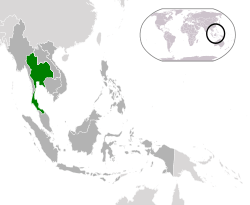 | |
| Capital and largest city | Bangkok 13°45′N 100°29′E |
| Official languages | Thai[1] |
| Spoken languages | |
| Ethnic groups |
|
| Religion |
|
| Demonym(s) | Thai Siamese (archaic) |
| Government | Unitary parliamentary constitutional monarchy |
• Monarch | Maha Vajiralongkorn |
| Prayut Chan-o-cha | |
| Legislature | National Assembly |
| Senate | |
| House of Representatives | |
| Formation | |
| 1238–1448 | |
| 1351–1767 | |
| 1768–1782 | |
• Rattanakosin Kingdom | 6 April 1782 |
| 24 June 1932 | |
| 6 April 2017 | |
| Area | |
• Total | 513,120 km2 (198,120 sq mi) (50th) |
• Water (%) | 0.4 (2,230 km2) |
| Population | |
• 2019 estimate | |
• 2010 census | 64,785,909[5] (21st) |
• Density | 132.1/km2 (342.1/sq mi) (88th) |
| GDP (PPP) | 2019 estimate |
• Total | $1.390 trillion[6] |
• Per capita | $20,474[6] |
| GDP (nominal) | 2019 estimate |
• Total | $516 billion[6][7] |
• Per capita | $7,607[6][7] |
| Gini (2015) | 36[8] medium |
| HDI (2018) | high · 77th |
| Currency | Baht (฿) (THB) |
| Time zone | UTC+7 (ICT) |
| Driving side | left |
| Calling code | +66 |
| ISO 3166 code | TH |
| Internet TLD | |
Tai peoples migrated from southwestern China to mainland Southeast Asia from the 11th century; the oldest known mention of their presence in the region by the exonym Siamese dates to the 12th century. Various Indianised kingdoms such as the Mon kingdoms, Khmer Empire and Malay states ruled the region, competing with Thai states such as the Kingdoms of Ngoenyang, Sukhothai, Lan Na and Ayutthaya, which rivalled each other. Documented European contact began in 1511 with a Portuguese diplomatic mission to Ayutthaya, which became a regional power by the end of the 15th century. Ayutthaya reached its peak during cosmopolitan Narai's reign (1656–1688), gradually declining thereafter until being ultimately destroyed in the 1767 Burmese–Siamese War. Taksin (r. 1767–1782) quickly reunified the fragmented territory and established the short-lived Thonburi Kingdom. He was succeeded in 1782 by Buddha Yodfa Chulaloke (r. 1782–1809), the first monarch of the current Chakri dynasty.
Through the 18th and 19th centuries, Siam faced imperialist pressure from France and the United Kingdom, including many unequal treaties with Western powers and forced concessions of territory; it nevertheless remained the only Southeast Asian country to avoid direct Western rule. Siamese system of government was centralized and transformed into modern unitary absolute monarchy in the reign of Chulalongkorn (r. 1868–1910). Siam joined World War I siding with the allies, a political decision to amend the unequal treaties. Following a bloodless revolution in 1932, Siam became a constitutional monarchy and changed its official name to "Thailand". Thailand was a satellite of Japan in World War II. In the late 1950s, a military coup under Field Marshal Sarit Thanarat revived the monarchy's historically influential role in politics. Thailand became a major ally of the United States, and played a key anti-communist role in the region as a member of the Southeast Asia Treaty Organization (SEATO). Apart from a brief period of parliamentary democracy in the mid-1970s, Thailand has periodically alternated between democracy and military rule. Since the 2000s, Thailand has been caught in a bitter political conflict between supporters and opponents of Thaksin Shinawatra, which culminated in two coups, most recently in 2014 and the establishment of its current and 20th constitution and faces the ongoing 2020 Thai protests.
Thailand is a founding member of the Association of Southeast Asian Nations (ASEAN) and remains a major ally of the United States.[12][13] Despite comparatively sporadic changes in leadership, it is considered a regional power in Southeast Asia and a middle power in global affairs.[14] With a high level of human development, the second-largest economy in Southeast Asia, and the 20th-largest in the world by PPP, Thailand is classified as a newly industrialized economy; manufacturing, agriculture, and tourism are leading sectors of the economy.[15][16]
Etymology
Thailand (/ˈtaɪlænd/ TY-land or /ˈtaɪlənd/ TY-lənd;[17] Thai: ประเทศไทย, RTGS: Prathet Thai, pronounced [pratʰêːt tʰaj] (![]()
![]()
Etymology of Siam
The country has always been called Mueang Thai by its citizens. By outsiders, prior to 1949, it was usually known by the exonym Siam (Thai: สยาม RTGS: sayam, pronounced [sajǎːm], also spelled Siem, Syâm, or Syâma). The word Siam may have originated from Pali (suvaṇṇabhūmi, 'land of gold') or Sanskrit श्याम (śyāma, 'dark') or Mon ရာမည(rhmañña, 'stranger'). The names Shan and A-hom seem to be variants of the same word. The word Śyâma is possibly not its origin, but a learned and artificial distortion.[18] Another theory is the name derives from Chinese: "Ayutthaya emerged as a dominant centre in the late 14th century. The Chinese called this region Xian, which the Portuguese converted into Siam."[19]:8 A further possibility is that Mon-speaking peoples migrating south called themselves syem as do the autochthonous Mon-Khmer-speaking inhabitants of the Malay Peninsula.
_of_Siam_Signature_(English).svg.png)
The signature of King Mongkut (r. 1851–1868) reads SPPM (Somdet Phra Poramenthra Maha) Mongkut Rex Siamensium (Mongkut King of the Siamese), giving the name Siam official status until 24 June 1939 when it was changed to "Thailand".[20] Thailand was renamed Siam from 1946 to 1948, after which it again reverted to "Thailand".
Etymology of "Thailand"
According to George Cœdès, the word Thai (ไทย) means 'free man' in the Thai language, "differentiating the Thai from the natives encompassed in Thai society as serfs".[21]:197 A famous Thai scholar argued that Thai (ไท) simply means 'people' or 'human being', since his investigation shows that in some rural areas the word "Thai" was used instead of the usual Thai word khon (คน) for people.[22] According to Michel Ferlus, the ethnonyms Thai-Tai (or Thay-Tay) would have evolved from the etymon *k(ə)ri: 'human being' through the following chain: *kəri: > *kəli: > *kədi:/*kədaj > *di:/*daj > *dajA (Proto-Southwestern Tai) > tʰajA2 (in Siamese and Lao) or > tajA2 (in the other Southwestern and Central Tai languages classified by Li Fangkuei).[23] Michel Ferlus's work is based on some simple rules of phonetic change observable in the Sinosphere and studied for the most part by William H. Baxter (1992).[24]
While Thai people will often refer to their country using the polite form prathet Thai (Thai: ประเทศไทย), they most commonly use the more colloquial term mueang Thai (Thai: เมืองไทย) or simply Thai; the word mueang, archaically referring to a city-state, is commonly used to refer to a city or town as the centre of a region. Ratcha Anachak Thai (Thai: ราชอาณาจักรไทย) means 'kingdom of Thailand' or 'kingdom of Thai'. Etymologically, its components are: ratcha (Sanskrit: राजन्, rājan, 'king, royal, realm'); -ana- (Pali āṇā 'authority, command, power', itself from the Sanskrit आज्ञा, ājñā, of the same meaning) -chak (from Sanskrit चक्र cakra- 'wheel', a symbol of power and rule). The Thai National Anthem (Thai: เพลงชาติ), written by Luang Saranupraphan during the patriotic 1930s, refers to the Thai nation as prathet Thai (Thai: ประเทศไทย). The first line of the national anthem is: prathet thai ruam lueat nuea chat chuea thai (Thai: ประเทศไทยรวมเลือดเนื้อชาติเชื้อไทย), 'Thailand is the unity of Thai flesh and blood'.
History
Prehistory

There is evidence of continuous human habitation in present-day Thailand from 20,000 years ago to the present day.[26]:4 The earliest evidence of rice growing is dated at 2,000 BCE.[25]:4 Bronze appeared circa 1,250–1,000 BCE.[25]:4 The site of Ban Chiang in northeast Thailand currently ranks as the earliest known centre of copper and bronze production in Southeast Asia.[27] Iron appeared around 500 BCE.[25]:5 The Kingdom of Funan was the first and most powerful Southeast Asian kingdom at the time (2nd century BCE).[26]:5 The Mon people established the principalities of Dvaravati and Kingdom of Hariphunchai in the 6th century. The Khmer people established the Khmer empire, centred in Angkor, in the 9th century.[26]:7 Tambralinga, a Malay state controlling trade through the Malacca Strait, rose in the 10th century.[26]:5 The Indochina peninsula was heavily influenced by the culture and religions of India from the time of the Kingdom of Funan to that of the Khmer Empire.[28]
The Thai people are of the Tai ethnic group, characterised by common linguistic roots.[29]:2 Chinese chronicles first mention the Tai peoples in the 6th century BCE. While there are many assumptions regarding the origin of Tai peoples, David K. Wyatt, a historian of Thailand, argued that their ancestors which at the present inhabit Laos, Thailand, Myanmar, India, and China came from the Điện Biên Phủ area between the 5th and the 8th century.[29]:6 Thai people began migrating into present-day Thailand around the 11th century, which Mon and Khmer people occupied at the time.[30] Thus Thai culture was influenced by Indian, Mon, and Khmer cultures.[31]
According to French historian George Cœdès, "The Thai first enter history of Farther India in the eleventh century with the mention of Syam slaves or prisoners of war in Champa epigraphy, and "in the twelfth century, the bas-reliefs of Angkor Wat" where "a group of warriors" are described as Syam.[21]:190–191, 194–195
Early states and Sukhothai Kingdom
After the decline of the Khmer Empire and Kingdom of Pagan in the early-13th century, various states thrived in their place. The domains of Tai people existed from the northeast of present-day India to the north of present-day Laos and to the Malay peninsula.[29]:38–9 During the 13th century, Tai people had already settled in the core land of Dvaravati and Lavo Kingdom to Nakhon Si Thammarat in the south. There are, however, no records detailing the arrival of the Tais.[29]:50–1
Around 1240, Pho Khun Bang Klang Hao, a local Tai ruler, rallied the people to rebel against the Khmer. He later crowned himself the first king of Sukhothai Kingdom in 1238.[29]:52–3 Mainstream Thai historians count Sukhothai as the first kingdom of Thai people. Sukhothai expanded furthest during the reign of Ram Khamhaeng (r. 1279–1298). However, it was mostly a network of local lords who swore fealty to Sukhothai, not directly controlled by it.[29]:55–6 He is believed have invented Thai script and Thai ceramics were an important export in his era. Sukhothai embraced Theravada Buddhism in the reign of Maha Thammaracha I (1347–1368).
To the north, Mangrai, who descended from a local ruler lineage of Ngoenyang, founded the kingdom of Lan Na in 1292, centered in Chiang Mai. He unified the surrounding area and his dynasty would rule the kingdom continuously for the next two centuries. He also created a network of states through political alliances to the east and north of the Mekong.[19]:8 While in the port in Lower Chao Phraya Basin, a federation around Phetchaburi, Suphan Buri, Lopburi, and the Ayutthaya area was created in the 11th century.[19]:8
Ayutthaya Kingdom
According to the most widely accepted version of its origin, the Ayutthaya Kingdom rose from the earlier, nearby Lavo Kingdom and Suvarnabhumi with Uthong as its first king. Ayutthaya was a patchwork of self-governing principalities and tributary provinces owing allegiance to the King of Ayutthaya under the mandala system.[32]:355 Its initial expansion was through conquest and political marriage. Before the end of the 15th century, Ayutthaya invaded the Khmer Empire three times and sacked its capital Angkor.[33]:26 Ayutthaya then became a regional power in place of the Khmer. Constant interference of Sukhothai effectively made it a vassal state of Ayutthaya and it was finally incorporated into the kingdom. Borommatrailokkanat brought about bureaucratic reforms which lasted into the 20th century and created a system of social hierarchy called sakdina, where male commoners were conscripted as corvée labourers for six months a year.[34]:107 Ayutthaya was interested in the Malay peninsula, but failed to conquer the Malacca Sultanate which was supported by the Chinese Ming Dynasty.[26]:11, 13
European contact and trade started in the early-16th century, with the envoy of Portuguese duke Afonso de Albuquerque in 1511, Portugal became an allied and ceded some soldiers to King Rama Thibodi II.[35] The Portuguese were followed in the 17th century by the French, Dutch, and English. Rivalry for supremacy over Chiang Mai and the Mon people pitted Ayutthaya against the Burmese Kingdom. Several wars with its ruling dynasty Taungoo Dynasty starting in the 1540s in the reign of Tabinshwehti and Bayinnaung were ultimately ended with the capture of the capital in 1570.[34]:146–7 Then was a brief period of vassalage to Burma until Naresuan proclaimed independence in 1584.[19]:11
Ayutthaya then sought to improve relations with European powers for many successive reigns. The kingdom especially prospered during cosmopolitan Narai's reign (1656–1688) when some European travelers regarded Ayutthaya as an Asian great power, alongside China and India.[25]:ix However, growing French influence later in his reign was met with nationalist sentiment and led eventually to the Siamese revolution of 1688.[34]:185–6 However, overall relations remained stable, with French missionaries still active in preaching Christianity.[34]:186
After a bloody period of dynastic struggle, Ayutthaya entered into what has been called the golden age, a relatively peaceful episode in the second quarter of the 18th century when art, literature, and learning flourished. There were seldom foreign wars, apart from conflict with the Nguyễn Lords for control of Cambodia starting around 1715. The last fifty years of the kingdom witnessed bloody succession crises, where there were purges of court officials and able generals for many consecutive reigns. In 1765, a combined 40,000-strong force of Burmese armies invaded it from the north and west.[36]:250 The Burmese were under the new Alaungpaya dynasty quickly rose to be a new local power by 1759. After a 14-month siege, the capital city's wall fell and the city was burned in April 1767.[37]:218
Thonburi Kingdom
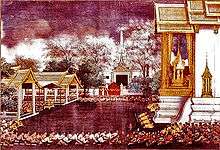
The capital and much territories lied in chaos after the war. The former capital was occupied by the Burmese garrison army and five local leaders declared themselves overlords, including the lords of Sakwangburi, Pimai, Chanthaburi, and Nakhon Si Thammarat. Chao Tak, a capable military leader, proceeded to make himself a lord by right of conquest, beginning with the legendary sack of Chanthaburi. Based at Chanthaburi, Chao Tak raised troops and resources, and sent a fleet up the Chao Phraya to take the fort of Thonburi. In the same year, Chao Tak was able to retake Ayutthaya from the Burmese only seven months after the fall of the city.[38]
Chao Tak then crowned himself as Taksin and proclaimed Thonburi as temporary capital in the same year. He also quickly subdued the other warlords. His forces engaged in wars with Burma, Laos, and Cambodia, which successfully drove the Burmese out of Lan Na in 1775,[34]:225 captured Vientiane in 1778[34]:227–8 and tried to install a pro-Thai king in Cambodia in the 1770s. In his final years there was a coup, caused supposedly by his "insanity", and eventually Taksin and his sons were executed by his longtime companion General Chao Phraya Chakri (the future Rama I). He was the first king of the ruling Chakri Dynasty and founder of the Rattanakosin Kingdom on 6 April 1782.
Modernisation and centralisation
Under Rama I (1782–1809), Rattanakosin successfully defended against Burmese attacks and put an end to Burmese incursions. He also created suzerainty over large portions of Laos and Cambodia.[39] In 1821, Briton John Crawfurd was sent to negotiate a new trade agreement with Siam – the first sign of an issue which was to dominate 19th century Siamese politics.[40] Bangkok signed the Burney Treaty in 1826, after the British victory in the First Anglo-Burmese War.[34]:281 Anouvong of Vientiane, who misunderstood that Britain was about to attack Bangkok, started the Lao rebellion in 1826 and was defeated.[34]:283–5 Vientiane was destroyed and a large number of Lao people was relocated to Khorat Plateau as a result.[34]:285–6 Bangkok also waged several wars with Vietnam, where Bangkok successfully regained hegemony over Cambodia.[34]:290–2
From the late-19th century, Siam tried to rule the ethnic groups in the realm as colonies.[34]:308 In the reign of Mongkut (1851–1868), who recognised the threat of Western powers, his court contacted the British government directly to defuse tensions.[34]:311 A British mission led by Sir John Bowring, Governor of Hong Kong, led to the signing of the Bowring Treaty, the first of many unequal treaties with Western countries. This, however, brought trade and economic development in Bangkok.[41] The unexpected death of Mongkut from malaria led to the reign of underage Prince Chulalongkorn, with Somdet Chaophraya Sri Suriwongse (Chuang Bunnag) acting as regent.[34]:327
Chulalongkorn (r. 1868–1910) initiated centralisation, set up a privy council, and abolished slavery and the corvée system.[34] The Front Palace crisis of 1874 stalled attempts at further reforms.[34]:331–3 In the 1870s and 1880s, he incorporated the protectorates up north into the kingdom proper, which later expanded to the protectorates in the northeast and the south.[34]:334–5 He established twelve krom in 1888, which were equivalent to present-day ministries.[34]:347 The crisis of 1893 erupted, caused by French demands for Lao territory east of Mekong.[34]:350–3 Thailand is the only Southeast Asian nation not to have been colonised by a Western power,[42] in part because Britain and France agreed in 1896 to make the Chao Phraya valley a buffer state.[43] Not until the 20th century could Siam renegotiate every unequal treaty dating from the Bowring Treaty, including extraterritoriality, but at a price of many territorial exchanges. The advent of the monthon system marked the creation of the modern Thai nation-state.[34]:362–3 In 1905, there were unsuccessful rebellions in the ancient Patani area, Ubon Ratchathani, and Phrae in opposition to an attempt to blunt the power of local lords.[34]:371–3
The Palace Revolt of 1912 was a failed attempt by Western-educated military officers to overthrow the absolute monarchy.[34]:397 Vajiravudh (r. 1910–1925) responded by propaganda for the entirety of his reign.[34]:402 He promoted the idea of the Thai nation.[34]:404 In 1917, Siam joined World War I on the side of the Allies as there were concerns that the Allies might punish neutral countries and refuse to amend past unequal treaties.[34]:407 In the aftermath Siam joined the Paris Peace Conference, and gained freedom of taxation and the revocation of extraterritoriality.[34]:408
Constitutional monarchy, World War II and Cold War
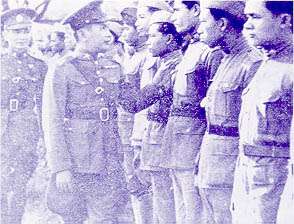
A bloodless revolution took place in 1932, carried out by a group of military and civilian officials Khana Ratsadon. Prajadhipok was forced to grant the country's first constitution, thereby ending centuries of absolute monarchy. The combined results of economic hardships brought on by the Great Depression, sharply falling rice prices, and a significant reduction in public spending caused discontent among aristocrats.[26]:25 In 1933, A counter-revolutionary rebellion occurred which aimed to reinstate absolute monarchy, but failed.[34]:446–8 Prajadhipok's conflict with the government eventually led to abdication. The government selected Ananda Mahidol, who was studying in Switzerland, to be the new king.[34]:448–9
Later that decade, the army wing of Khana Ratsadon came to dominate Siamese politics. Plaek Phibunsongkhram who became premier in 1938, started political oppression and took an openly anti-royalist stance.[34]:457 His government adopted nationalism and Westernisation, anti-Chinese and anti-French policies.[26]:28 In 1940, there was a decree changing the name of the country from "Siam" to "Thailand". In 1941, Thailand was in a brief conflict with Vichy France resulting in Thailand gaining some Lao and Cambodian territories.[34]:462 On 8 December 1941, the Empire of Japan launched an invasion of Thailand, and fighting broke out shortly before Phibun ordered an armistice. Japan was granted free passage, and on 21 December Thailand and Japan signed a military alliance with a secret protocol, wherein Tokyo agreed to help Thailand regain territories lost to the British and French.[44] The Thai government declared war on the United States and the United Kingdom.[34]:465 The Free Thai Movement was launched both in Thailand and abroad to oppose the government and Japanese occupation.[34]:465–6 After the war ended in 1945, Thailand signed formal agreements to end the state of war with the Allies. Most Allied powers had not recognised Thailand's declaration of war.
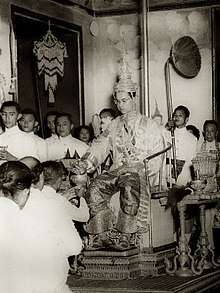
In June 1946, young King Ananda was found dead under mysterious circumstances. His younger brother Bhumibol Adulyadej ascended to the throne. Thailand joined the Southeast Asia Treaty Organization (SEATO) to become an active ally of the United States in 1954.[34]:493 Field Marshal Sarit Thanarat launched a coup in 1957, which removed Khana Ratsadon from politics. His rule (premiership 1959–1963) was autocratic; he built his legitimacy around the god-like status of the monarch and by channelling the government's loyalty to the king.[34]:511 His government improved the country's infrastructure and education.[34]:514 After the US joined the Vietnam War in 1961, there was a secret agreement wherein the US promised to protect Thailand.[34]:523
The period brought about increasing modernisation and Westernisation of Thai society. Rapid urbanisation occurred when the rural populace sought work in growing cities. Rural farmers gained class consciousness and were sympathetic to the Communist Party of Thailand.[34]:528 Economic development and education enabled the rise of a middle class in Bangkok and other cities.[34]:534 In October 1971, there was a large demonstration against the dictatorship of Thanom Kittikachorn (premiership 1963–1973), which led to civilian casualties.[34]:541–3 Bhumibol installed Sanya Dharmasakti (premiership 1973–1975) to replace him, making it the first time that the king intervened in Thai politics directly since 1932.[45] The aftermath of the event marked a short-lived parliamentary democracy,[45] often called the "era when democracy blossomed." (ยุคประชาธิปไตยเบ่งบาน)
Contemporary history
Constant unrest and instability, as well as fear of a communist takeover after the fall of Saigon, made some ultra-right groups brand leftist students as communists.[34]:548 This culminated in the Thammasat University massacre in October 1976.[34]:548–9 A coup d'état on that day brought Thailand a new ultra-right government, which cracked down on media outlets, officials, and intellectuals, and fuelled the communist insurgency. Another coup the following year installed a more moderate government, which offered amnesty to communist fighters in 1978.
Fueled by Indochina refugee crisis, Vietnamese border raids and economic hardships, Prem Tinsulanonda launched a successful coup and became the Prime Minister from 1980 to 1988. The communists abandoned the insurgency by 1983. Prem's premiership was dubbed "semi-democracy" because the Parliament was composed of all elected House and all appointed Senate. The 1980s also saw increasing intervention in politics by the monarch, who rendered two coup attempts against Prem failed. Thailand had its first elected prime minister in 1988.[46]
Suchinda Kraprayoon, who was the coup leader in 1991 and said he would not seek to become prime minister, was nominated as one by the majority coalition government after the 1992 general election. This caused a popular demonstration in Bangkok, which ended with a military crackdown. Bhumibol intervened in the event and Suchinda then resigned.
The 1997 Asian financial crisis originated in Thailand and ended the country's 40 years of uninterrupted economic growth.[47]:3 Chuan Leekpai's government took an IMF loan with unpopular provisions.[34]:576 The populist Thai Rak Thai party, led by prime minister Thaksin Shinawatra, governed from 2001 until 2006. His policies were successful in reducing rural poverty[48] and initiated universal healthcare in the country.[49] A South Thailand insurgency escalated starting from 2004. The 2004 Indian Ocean earthquake and tsunami hit the country, mostly in the south. Massive protests against Thaksin led by the People's Alliance for Democracy (PAD) started in his second term as prime minister and his tenure ended with a coup d'état in 2006. The junta installed a military government which lasted a year.
In 2007, a civilian government led by the Thaksin-allied People's Power Party (PPP) was elected. Another protest led by PAD ended with the dissolution of PPP, and the Democrat Party led a coalition government in its place. The pro-Thaksin United Front for Democracy Against Dictatorship (UDD) protested both in 2009 and in 2010.
After the general election of 2011, the populist Pheu Thai Party won a majority and Yingluck Shinawatra, Thaksin's younger sister, became prime minister. The People's Democratic Reform Committee organised another anti-Shinawatra protest[lower-alpha 3] after the ruling party proposed an amnesty bill which would benefit Thaksin.[50] Yingluck dissolved parliament and a general election was scheduled, but was invalidated by the Constitution Court. The crisis ended with another coup d'état in 2014, the second coup in a decade.[lower-alpha 4] The National Council for Peace and Order, a military junta led by General Prayut Chan-o-cha, has led the country since. Civil and political rights were restricted, and the country saw a surge in lèse-majesté cases. Political opponents and dissenters were sent to "attitude adjustment" camps.[51] Bhumibol, the longest-reigning Thai king, died in 2016, and his son Vajiralongkorn ascended to the throne. The referendum and adoption of Thailand's current constitution happened under the junta's rule.[lower-alpha 5] In 2019, the junta agreed to schedule a general election in March.[51] Prayut continued his premiership with the support of Palang Pracharath Party-coalition in the House and junta-appointed Senate, amid allegations of election fraud.[53]
Politics and government
Prior to 1932, Thai kings were absolute monarchs. During Sukhothai Kingdom, the king was seen as a Dharmaraja or 'king who rules in accordance with Dharma'. The system of government was a network of tributaries ruled by local lords. Modern absolute monarchy and statehood was established by Chulalongkorn when he transformed the decentralized protectorate system into a unitary state. On 24 June 1932, Khana Ratsadon (People's Party) carried out a bloodless revolution which marked the beginning of constitutional monarchy.
Thailand has had 20 constitutions and charters since 1932, including the latest and current 2017 Constitution. Throughout this time, the form of government has ranged from military dictatorship to electoral democracy.[54][55] Thailand has had the fourth-most coups in the world.[56] "Uniformed or ex-military men have led Thailand for 55 of the 83 years" between 1932 and 2009.[57] Most recently, the National Council for Peace and Order ruled the country between 2014 and 2019.
The politics of Thailand is conducted within the framework of a constitutional monarchy, whereby a hereditary monarch is head of state. The current King of Thailand is Vajiralongkorn (or Rama X), who has reigned since October 2016. The powers of the king are limited by the constitution and he is primarily a symbolic figurehead. The monarch is head of the armed forces and is required to be Buddhist as well as the Defender of the Faith. He has the power to appoint his heirs, the power to grant pardons, and the royal assent. The king is aided in his duties by the Privy Council of Thailand. However, the monarch still occasionally intervenes in Thai politics, as all constitutions pave the way for customary royal rulings. The monarchy is widely revered and lèse majesté is a severe crime in Thailand.
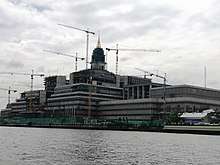
Government is separated into three branches:
- The legislative branch: the National Assembly is composed of the Senate, the 150-member fully appointed upper house, and House of Representatives, the 350-member lower house. Its most recent election is the 2019 general election. The coalition led by Palang Pracharath Party currently holds the majority.
- The executive branch consisting of the Prime Minister of Thailand who was elected by the National Assembly and other cabinet members of up to 35 people. The cabinet was appointed by the king on the advice of the prime minister. The prime minister is the head of government.
- The judiciary is supposed to be independent of the executive and the legislative branches, although judicial rulings are suspected of being based on political considerations rather than on existing law.[58]
Military and bureaucratic aristocrats fully controlled political parties between 1946 and 1980s.[59]:16 Most parties in Thailand are short-lived.[60]:246 Between 1992 and 2006, Thailand had a two-party system.[60]:245 Since 2000, two political parties dominated Thai general elections: one was the Pheu Thai Party (which was a successor of People's Power Party and the Thai Rak Thai Party), and the other was the Democrat Party. The political parties which support Thaksin Shinawatra won the most representatives every general election since 2001. Later constitutions created a multi-party system where a single party cannot gain a majority in the house.
Lèse majesté
The 2007 constitution was partially abrogated by the military dictatorship that came to power in May 2014.[61]
Thailand's kings are protected by lèse-majesté laws which allow critics to be jailed for three to fifteen years.[62] After the 2014 Thai coup d'état, Thailand had the highest number of lèse-majesté prisoners in the nation's history.[63][64] In 2017, the military court in Thailand sentenced a man to 35 years in prison for violating the country's lèse-majesté law.[64] Thailand has been rated not free on the Freedom House Index since 2014.[65] Thai activist and magazine editor Somyot Prueksakasemsuk, who was sentenced to eleven years' imprisonment for lèse-majesté in 2013,[66] is a designated prisoner of conscience by Amnesty International.[67]
Geography
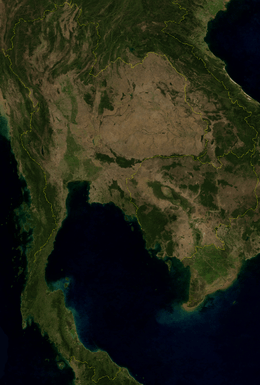
Totalling 513,120 square kilometres (198,120 sq mi), Thailand is the 50th-largest country by total area. It is slightly smaller than Yemen and slightly larger than Spain.[1]
Thailand comprises several distinct geographic regions, partly corresponding to the provincial groups. The north of the country is the mountainous area of the Thai highlands, with the highest point being Doi Inthanon in the Thanon Thong Chai Range at 2,565 metres (8,415 ft) above sea level. The northeast, Isan, consists of the Khorat Plateau, bordered to the east by the Mekong River. The centre of the country is dominated by the predominantly flat Chao Phraya river valley, which runs into the Gulf of Thailand.
Southern Thailand consists of the narrow Kra Isthmus that widens into the Malay Peninsula. Politically, there are six geographical regions which differ from the others in population, basic resources, natural features, and level of social and economic development. The diversity of the regions is the most pronounced attribute of Thailand's physical setting.
The Chao Phraya and the Mekong River are the indispensable water courses of rural Thailand. Industrial scale production of crops use both rivers and their tributaries. The Gulf of Thailand covers 320,000 square kilometres (124,000 sq mi) and is fed by the Chao Phraya, Mae Klong, Bang Pakong, and Tapi Rivers. It contributes to the tourism sector owing to its clear shallow waters along the coasts in the southern region and the Kra Isthmus. The eastern shore of the Gulf of Thailand is an industrial centre of Thailand with the kingdom's premier deepwater port in Sattahip and its busiest commercial port, Laem Chabang.
The Andaman Sea is a precious natural resource as it hosts popular and luxurious resorts. Phuket, Krabi, Ranong, Phang Nga and Trang, and their islands, all lay along the coasts of the Andaman Sea and, despite the 2004 tsunami, they remain a tourist magnet.
Climate
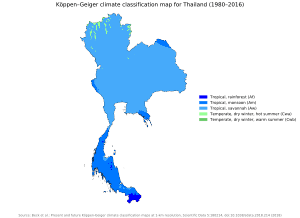
Thailand's climate is influenced by monsoon winds that have a seasonal character (the southwest and northeast monsoon).[68]:2 Most of the country is classified as Köppen's tropical savanna climate.[69] The majority of the south as well as the eastern tip of the east have a tropical monsoon climate. Parts of the south also have a tropical rainforest climate.
Thailand is divided into three seasons.[68]:2 The first is the rainy or southwest monsoon season (mid–May to mid–October), which is caused by southwestern wind from Indian Ocean.[68]:2 Rainfall is also contributed by Intertropical Convergence Zone (ITCZ) and tropical cyclones.[68]:2 August and September being the wettest period of the year.[68]:2 The country receives a mean annual rainfall of 1,200 to 1,600 mm (47 to 63 in).[68]:4 Winter or the northeast monsoon starts from mid–October until mid–February.[68]:2 Most of Thailand experiences dry weather with mild temperatures.[68]:2,4 Summer or the pre–monsoon season runs from mid–February until mid–May.[68]:3 Due to its inland nature and latitude, the north, northeast, central and eastern parts of Thailand experience a long period of warm weather, where temperatures can reach up to 40 °C (104 °F) during March to May,[68]:3 in contrast to close to or below 0 °C (32 °F) in some areas in winter.[68]:3 Southern Thailand is characterised by mild weather year-round with less diurnal and seasonal variations in temperatures due to maritime influences.[68]:3 It receives abundant rainfall, particularly during October to November.[68]:2
Thailand is among the world's ten countries that are most exposed to climate change; in particular, it is highly vulnerable to rising sea levels and extreme weather events.[70][71]
Environment and wildlife
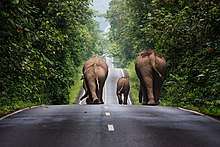
Thailand has a mediocre but improving performance in the global Environmental Performance Index (EPI) with an overall ranking of 91 out of 180 countries in 2016. The environmental areas where Thailand performs worst (i.e., highest ranking) are air quality (167), environmental effects of the agricultural industry (106), and the climate and energy sector (93), the later mainly because of a high CO2 emission per KWh produced. Thailand performs best (i.e., lowest ranking) in water resource management (66), with some major improvements expected for the future, and sanitation (68).[73][74]
The population of elephants, the country's national symbol, has fallen from fallen from 100,000 in 1850 to an estimated 2,000.[72] Poachers have long hunted elephants for ivory and hides, and now increasingly for meat.[75] Young elephants are often captured for use in tourist attractions or as work animals, which there were claims of mistreatment.[76] Although their use has declined since the government banned logging in 1989.
Poaching of protected species remains a major problem. Tigers, leopards, and other large cats are hunted for their pelts. Many are farmed or hunted for their meat, supposedly has medicinal properties. Although such trade is illegal, the well-known Bangkok market Chatuchak is still known for the sale of endangered species.[77] The practice of keeping wild animals as pets affects species such as Asiatic black bear, Malayan sun bear, white-handed lar, pileated gibbon, and binturong.[78]
Administrative divisions
Thailand is a unitary state; the administrative services of the executive branch are divided into three levels by National Government Organisation Act, BE 2534 (1991): central, provincial and local. Thailand is composed of 76 provinces (จังหวัด, changwat), which are first-level administrative divisions.[79] There are also two specially governed districts: the capital Bangkok and Pattaya. Bangkok is at provincial level and thus often counted as a province. Each province is divided into districts (อำเภอ, amphoe) and the districts are further divided into sub-districts (ตำบล, tambons). The name of each province's capital city (เมือง, mueang) is the same as that of the province. For example, the capital of Chiang Mai Province (Changwat Chiang Mai) is Mueang Chiang Mai or Chiang Mai. All provincial governors and district chiefs, which are administrators of provinces and districts respectively, are appointed by the central government.[80] Thailand's provinces are sometimes grouped into four to six regions, depending on the source.
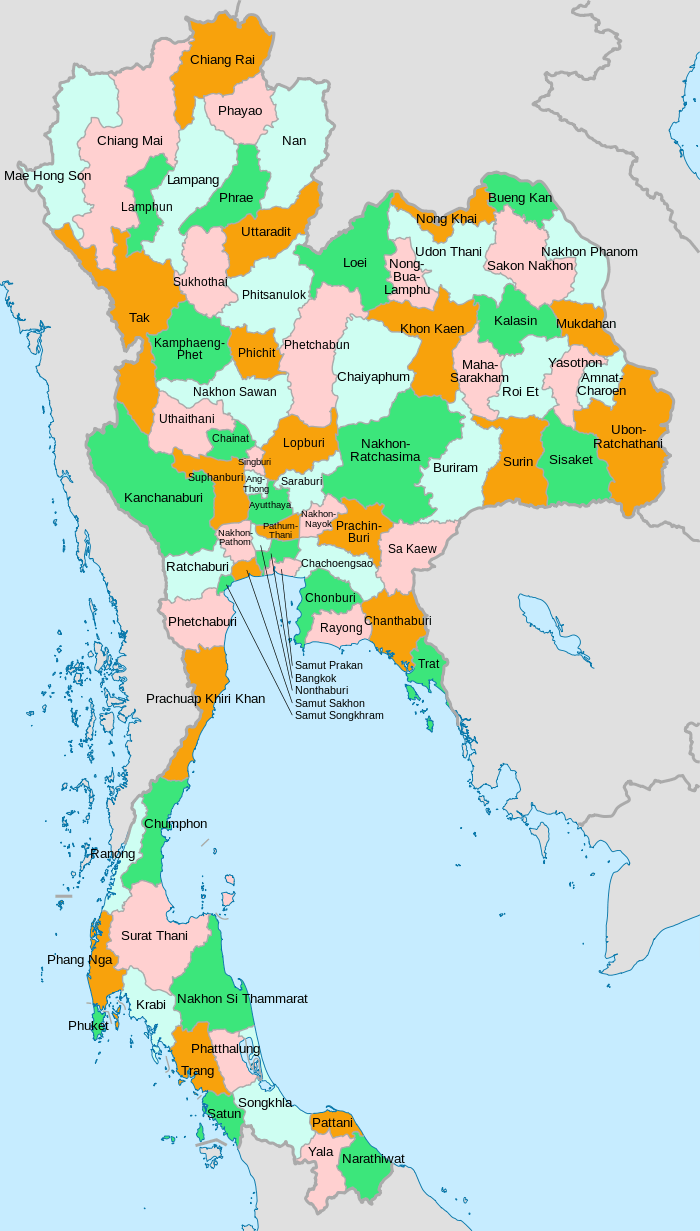

Foreign relations

The foreign relations of Thailand are handled by the Minister of Foreign Affairs.
Thailand participates fully in international and regional organisations. It is a major non-NATO ally and Priority Watch List Special 301 Report of the United States. The country remains an active member of ASEAN Association of Southeast Asian Nations. Thailand has developed increasingly close ties with other ASEAN members: Indonesia, Malaysia, the Philippines, Singapore, Brunei, Laos, Cambodia, Myanmar, and Vietnam, whose foreign and economic ministers hold annual meetings. Regional co-operation is progressing in economic, trade, banking, political, and cultural matters. In 2003, Thailand served as APEC (Asia Pacific Economic Cooperation) host. Dr. Supachai Panitchpakdi, the former Deputy Prime Minister of Thailand, currently serves as Secretary-General of the United Nations Conference on Trade and Development (UNCTAD). In 2005 Thailand attended the inaugural East Asia Summit.
In recent years, Thailand has taken an increasingly active role on the international stage. When East Timor gained independence from Indonesia, Thailand, for the first time in its history, contributed troops to the international peacekeeping effort. Its troops remain there today as part of a UN peacekeeping force. As part of its effort to increase international ties, Thailand has reached out to such regional organisations as the Organization of American States (OAS) and the Organisation for Security and Cooperation in Europe (OSCE). Thailand has contributed troops to reconstruction efforts in Afghanistan and Iraq.
Thaksin initiated negotiations for several free trade agreements with China, Australia, Bahrain, India, and the US. The latter especially was criticised, with claims that uncompetitive Thai industries could be wiped out.[81]
Thaksin also announced that Thailand would forsake foreign aid, and work with donor countries to assist in the development of neighbours in the Greater Mekong Sub-region.[82] Thaksin sought to position Thailand as a regional leader, initiating various development projects in poorer neighbouring countries like Laos. More controversially, he established close, friendly ties with the Burmese dictatorship.[83]
Thailand joined the US-led invasion of Iraq, sending a 423-strong humanitarian contingent.[84] It withdrew its troops on 10 September 2004. Two Thai soldiers died in Iraq in an insurgent attack.
Abhisit appointed Peoples Alliance for Democracy leader Kasit Piromya as foreign minister. In April 2009, fighting broke out between Thai and Cambodian troops on territory immediately adjacent to the 900-year-old ruins of Cambodia's Preah Vihear Hindu temple near the border. The Cambodian government claimed its army had killed at least four Thais and captured 10 more, although the Thai government denied that any Thai soldiers were killed or injured. Two Cambodian and three Thai soldiers were killed. Both armies blamed the other for firing first and denied entering the other's territory.[85][86]
Armed forces
The Royal Thai Armed Forces (กองทัพไทย; RTGS: Kong Thap Thai) constitute the military of the Kingdom of Thailand. It consists of the Royal Thai Army (กองทัพบกไทย), the Royal Thai Navy (กองทัพเรือไทย), and the Royal Thai Air Force (กองทัพอากาศไทย). It also incorporates various paramilitary forces.
The Thai Armed Forces have a combined manpower of 306,000 active duty personnel and another 245,000 active reserve personnel.[87] The head of the Thai Armed Forces (จอมทัพไทย, Chom Thap Thai) is the king,[88] although this position is only nominal. The armed forces are managed by the Ministry of Defence of Thailand, which is headed by the Minister of Defence (a member of the cabinet of Thailand) and commanded by the Royal Thai Armed Forces Headquarters, which in turn is headed by the Chief of Defence Forces of Thailand.[89] Thai annual defense budget almost tripled from 78 billion baht in 2005 to 207 billion baht in 2016, accounting for approximately 1.5% of 2019 Thai GDP.[90][91] Thailand ranked 16th worldwide in the Military Strength Index based on the Credit Suisse report in September 2015.
.jpg)
The military is also tasked with humanitarian missions, such as escorting Rohingya to Malaysia or Indonesia,[92] ensuring security and welfare for refugees during Indochina refugee crisis.[93]
According to the constitution, serving in the armed forces is a duty of all Thai citizens.[94] Thailand still use active draft system for males over the age of 21. They are subjected to varying lengths of active service depending on the duration of reserve training as Territorial Defence Student and their level of education. Those who have completed three years or more of reserve training will be exempted entirely. The practice has long been criticized, as some media question its efficacy and value.[95][96] It is alleged that conscripts end up as servants to senior officers[97] or clerks in military cooperative shops.[98][99] In a report issued in March 2020, Amnesty International charged that Thai military conscripts face institutionalised abuse systematically hushed up by military authorities.[100]
Critics observed that Thai military's main objective is to deal with internal rather than external threats.[101] Internal Security Operations Command is called the political arm of the Thai military, which has overlapping social and political functions with civilian bureaucracy. It also has anti-democracy mission.[101] The military is also notorious for numerous corruption incidents, such as accusation of human trafficking,[102] and nepotism in promotion of high-ranking officers.[103] The military is deeply entrenched in politics. Most recently, the appointed senators include more than 100 active and retired military.[104]
In 2017, Thailand signed and ratified the UN Treaty on the Prohibition of Nuclear Weapons.[105]
Education

In 2018 the literacy rate was 93.8%. The youth literacy rate was 98.1% in 2015.[106] Education is provided by a well-organised school system of kindergartens, primary, lower secondary and upper secondary schools, numerous vocational colleges, and universities. The private sector of education is well developed and significantly contributes to the overall provision of education which the government would not be able to meet with public establishments. Education is compulsory up to and including age 14, with the government providing free education through to age 17. Thailand is the 3rd most popular study destination in Asean. The number of international degree students in Thailand increased by fully 979% between 1999 and 2012, from 1,882 to 20,309 students. The most of international students come from Asian neighbor countries[107] from China, Myanmar, Cambodia and Vietnam.[108] The number of higher education institutions in Thailand has grown strongly over the past decades from just a handful of universities in the 1970s to 156 officially. The two top-ranking universities in Thailand are Chulalongkorn University and Mahidol University.[109] Thai universities research output still relatively low by international ranking comparison, Recent initiatives, such as the National Research University from 9 universities around the country[110] and Graduate research intensive university: VISTEC, designed to strengthen Thailand's national research universities, however, appear to be gaining traction. Thailand's research output, as measured by journal publications, increased by 20% between 2011 and 2016.[111]

Teaching relies heavily on rote learning rather than on student-centred methodology. The establishment of reliable and coherent curricula for its primary and secondary schools is subject to such rapid changes that schools and their teachers are not always sure what they are supposed to be teaching, and authors and publishers of textbooks are unable to write and print new editions quickly enough to keep up with the volatility. Issues concerning university entrance has been in constant upheaval for a number of years. Nevertheless, Thai education has seen its greatest progress in the years since 2001. Most of the present generation of students are computer literate. Thailand was ranked 74th out of 100 countries globally for English proficiency.[112] Thailand has the second highest number of English-medium private international schools in Southeast Asian Nations, according to the International School Consultancy Group 181 schools around the country in 2017 compared to just 10 international schools for expatriate children in 1992.[107]
Students in ethnic minority areas score consistently lower in standardised national and international tests.[113][114][115] This is likely due to unequal allocation of educational resources, weak teacher training, poverty, and low Thai language skill, the language of the tests.[113] [116] [117]
Extensive nationwide IQ tests were administered to 72,780 Thai students from December 2010 to January 2011. The average IQ was found to be 98.59, which is higher than previous studies have found. IQ levels were found to be inconsistent throughout the country, with the lowest average of 88.07 found in the southern region of Narathiwat Province and the highest average of 108.91 reported in Nonthaburi Province. The Ministry of Public Health blames the discrepancies on iodine deficiency, and as of 2011 steps were being taken to require that iodine be added to table salt, a practice common in many Western countries.[118]
In 2013, the Ministry of Information and Communication Technology announced that 27,231 schools would receive classroom-level access to high-speed internet.[119]
Science and technology
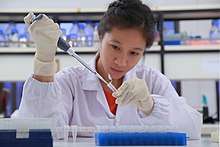
In modern times, Thai scientists have made many significant contributions in various fields of study. For example, In chemistry, Krisana Kraisintu as known as the "Gypsy pharmacist".[120] She developed one of the first generic ARV fixed-dose combinations and dedicated her life to making medicines more affordable and accessible. Her efforts have saved countless lives in Africa,GPO-VIR has now been chosen by World Health Organization as the first regimen treatment for HIV/AIDS patients in poor countries.[121] In Thailand, this drug (GPO-VIR) is used in the national HIV/AIDS treatment programme, making it free of charge for 100,000 patients.[122] while Pongrama Ramasoota, He discoveries production of therapeutic human monoclonal antibodies against dengue virus and the world's first Dengue fever medication, include DNA vaccine development for dengue and Canine parvovirus.[123]
Thailand has also made significant advances technology in the development of Medical Robotics. Medical robots have been used and promoted in Thailand in many areas, including surgery, diagnosis, rehabilitation and services.[124] and their use has been increasing. such as, an elderly care robot made by Thai manufacturer that Japanese nursing homes are widely using.[125] In surgery, back in 2019, The Medical Services Department has unveiled Thailand's robot created to help surgeons in brain surgery on patients afflicted with epilepsy.[126] back in 2017, Ramathibodi Hospital, a leading government hospital in Bangkok and a reputable medical school, successfully performed the first robot-assisted brain surgery in Asia.[127] For rehabilitation and therapy robots, were developed to help patients with arm and leg injuries perform practiced movements aided by the robots is the first prize winner of the i-MEDBOT Innovation Contest 2018 held by Thailand Center of Excellence for Life Sciences (TCELS).[128]
According to the UNESCO Institute for Statistics, Thailand devoted 1% of its GDP to science research and development in 2017.[129] Between 2014 and 2016, Research and development workforce in Thailand increased from 84,216 people to 112,386 people.[130] The Thai government is developing new growth hubs by starting with the Eastern Economic Corridor of Innovation (EECi) to accelerating human resource and research development.[131] The National Science and Technology Development Agency is an agency of the government of Thailand which supports research in science and technology and its application in the Thai economy.[132]
Economy
| Economic indicators | ||
|---|---|---|
| Nominal GDP | ฿14.53 trillion (2016) | [133] |
| GDP growth | 3.9% (2017) | [134] |
| Inflation • Headline • Core | 0.7% (2017) 0.6% (2017) | [134] |
| Employment-to-population ratio | 68.0% (2017) | [135]:29 |
| Unemployment | 1.2% (2017) | [134] |
| Total public debt | ฿6.37 trillion (Dec. 2017) | [136] |
| Poverty | 8.61% (2016) | [135]:36 |
| Net household worth | ฿20.34 trillion (2010) | [137]:2 |
Thailand is an emerging economy and is considered a newly industrialised country. Thailand had a 2017 GDP of US$1.236 trillion (on a purchasing power parity basis).[138] Thailand is the 2nd largest economy in Southeast Asia after Indonesia. Thailand ranks midway in the wealth spread in Southeast Asia as it is the 4th richest nation according to GDP per capita, after Singapore, Brunei, and Malaysia.
Thailand functions as an anchor economy for the neighbouring developing economies of Laos, Myanmar, and Cambodia. In the third quarter of 2014, the unemployment rate in Thailand stood at 0.84% according to Thailand's National Economic and Social Development Board (NESDB).[139]
Recent economic history
.jpeg)
Thailand experienced the world's highest economic growth rate from 1985 to 1996 – averaging 12.4% annually. In 1997 increased pressure on the baht, a year in which the economy contracted by 1.9%, led to a crisis that uncovered financial sector weaknesses and forced the Chavalit Yongchaiyudh administration to float the currency. Prime Minister Chavalit Yongchaiyudh was forced to resign after his cabinet came under fire for its slow response to the economic crisis. The baht was pegged at 25 to the US dollar from 1978 to 1997. The baht reached its lowest point of 56 to the US dollar in January 1998 and the economy contracted by 10.8% that year, triggering the Asian financial crisis.
Thailand's economy started to recover in 1999, expanding 4.2–4.4% in 2000, thanks largely to strong exports. Growth (2.2%) was dampened by the softening of the global economy in 2001, but picked up in the subsequent years owing to strong growth in Asia, a relatively weak baht encouraging exports, and increased domestic spending as a result of several mega projects and incentives of Prime Minister Thaksin Shinawatra, known as Thaksinomics. Growth in 2002, 2003, and 2004 was 5–7% annually.
Growth in 2005, 2006, and 2007 hovered around 4–5%. Due both to the weakening of the US dollar and an increasingly strong Thai currency, by March 2008 the dollar was hovering around the 33 baht mark. While Thaksinomics has received criticism, official economic data reveals that between 2001 and 2011, Isan's GDP per capita more than doubled to US$1,475, while, over the same period, GDP in the Bangkok area increased from US$7,900 to nearly US$13,000.[140]
With the instability surrounding major 2010 protests, the GDP growth of Thailand settled at around 4–5%, from highs of 5–7% under the previous civilian administration. Political uncertainty was identified as the primary cause of a decline in investor and consumer confidence. The IMF predicted that the Thai economy would rebound strongly from the low 0.1% GDP growth in 2011, to 5.5% in 2012 and then 7.5% in 2013, due to the monetary policy of the Bank of Thailand, as well as a package of fiscal stimulus measures introduced by the former Yingluck Shinawatra government.[141]
Following the Thai military coup of 22 May 2014. In 2017, Concluded with information on the Thai economy's grew an inflation-adjusted 3.9%, up from 3.3% in 2016, marking its fastest expansion since 2012.[142]
Income, poverty and wealth
Thais have median wealth per one adult person of $1,469 in 2016,[143]:98 increasing from $605 in 2010.[143]:34 In 2016, Thailand was ranked 87th in Human Development Index, and 70th in the inequality-adjusted HDI.[144]
In 2017, Thailand's median household income was ฿26,946 per month.[145]:1 Top quintile households had a 45.0% share of all income, while bottom quintile households had 7.1%.[145]:4 There were 26.9 million persons who had the bottom 40% of income earning less than ฿5,344 per person per month.[146]:5 During 2013–2014 Thai political crisis, a survey found that anti-government PDRC mostly (32%) had a monthly income of more than ฿50,000, while pro-government UDD mostly (27%) had between ฿10,000 and ฿20,000.[147]:7
In 2014, Credit Suisse reported that Thailand was the world's third most unequal country, behind Russia and India.[148] Top 10% richest held 79% of the country's asset.[148] Top 1% richest held 58% worth of the economy.[148] Thai 50 richest families had a total net worth accounting to 30% of GDP.[148]
In 2016, 5.81 million people lived in poverty, or 11.6 million people (17.2% of population) if "near poor" is included.[146]:1 Proportion of the poor relative to total population in each region was 12.96% in the Northeast, 12.35% in the South, and 9.83% in the North.[146]:2 In 2017, there were 14 million people who applied for social welfare (yearly income of less than ฿100,000 was required).[148] At the end of 2017, Thailand's total household debt was ฿11.76 trillion.[135]:5 In 2010, 3% of all household were bankrupt.[137]:5 In 2016, there were estimated 30,000 homeless persons in the country.[149]
Exports and manufacturing
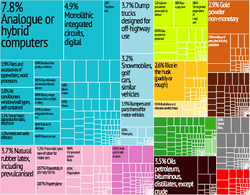
The economy of Thailand is heavily export-dependent, with exports accounting for more than two-thirds of gross domestic product (GDP). Thailand exports over US$105 billion worth of goods and services annually.[1] Major exports include cars, computers, electrical appliances, rice, textiles and footwear, fishery products, rubber, and jewellery.[1]
Substantial industries include electric appliances, components, computer components, and vehicles. Thailand's recovery from the 1997–1998 Asian financial crisis depended mainly on exports, among various other factors. As of 2012, the Thai automotive industry was the largest in Southeast Asia and the 9th largest in the world.[150][151][152] The Thailand industry has an annual output of near 1.5 million vehicles, mostly commercial vehicles.[152]
Most of the vehicles built in Thailand are developed and licensed by foreign producers, mainly Japanese and American. The Thai car industry takes advantage of the ASEAN Free Trade Area (AFTA) to find a market for many of its products. Eight manufacturers, five Japanese, two US, and Tata of India, produce pick-up trucks in Thailand.[153] As of 2012, Thailand was the second largest consumer of pick-up trucks in the world, after the US.[154] In 2014, pick-ups accounted for 42% of all new vehicle sales in Thailand.[153]
Tourism
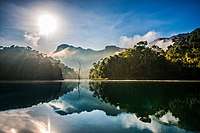
Tourism makes up about 6% of the country's economy. Thailand was the most visited country in Southeast Asia in 2013, according to the World Tourism Organisation. Estimates of tourism receipts directly contributing to the Thai GDP of 12 trillion baht range from 9 percent (1 trillion baht) (2013) to 16 percent.[155] When including the indirect effects of tourism, it is said to account for 20.2 percent (2.4 trillion baht) of Thailand's GDP.[156]:1
Asian tourists primarily visit Thailand for Bangkok and the historical, natural, and cultural sights in its vicinity. Western tourists not only visit Bangkok and surroundings, but in addition many travel to the southern beaches and islands. The north is the chief destination for trekking and adventure travel with its diverse ethnic minority groups and forested mountains. The region hosting the fewest tourists is Isan. To accommodate foreign visitors, a separate tourism police with offices were set up in the major tourist areas and an emergency telephone number.[157]
Thailand ranks 5th biggest medical tourism destination of inbound medical tourism spending, according to World Travel and Tourism Council, attracting over 2.5 million visitors in 2018.[158] The country is also Asia's number one.[159] The country is popular for the growing practice of sex reassignment surgery (SRS) and cosmetic surgery. In 2010–2012, more than 90% of the visitors travelled to Thailand for SRS.[160]
Prostitution in Thailand and sex tourism also form a de facto part of the economy. Campaigns promote Thailand as exotic to attract tourists.[161] One estimate published in 2003 placed the trade at US$4.3 billion per year or about 3% of the Thai economy.[162] It is believed that at least 10% of tourist dollars are spent on the sex trade.[163]
Agriculture and natural resources
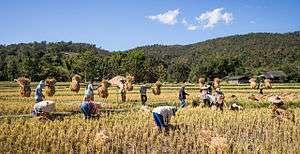
Forty-nine per cent of Thailand's labour force is employed in agriculture.[164] This is down from 70% in 1980.[164] Rice is the most important crop in the country and Thailand had long been the world's leading exporter of rice, until recently falling behind both India and Vietnam.[165] Thailand has the highest percentage of arable land, 27.25%, of any nation in the Greater Mekong Subregion.[166] About 55% of the arable land area is used for rice production.[167]
Agriculture has been experiencing a transition from labour-intensive and transitional methods to a more industrialised and competitive sector.[164] Between 1962 and 1983, the agricultural sector grew by 4.1% per year on average and continued to grow at 2.2% between 1983 and 2007.[164] The relative contribution of agriculture to GDP has declined while exports of goods and services have increased.
Furthermore, access to biocapacity in Thailand is lower than world average. In 2016, Thailand had 1.2 global hectares[168] of biocapacity per person within its territory, a little less than world average of 1.6 global hectares per person.[169] In contrast, in 2016, they used 2.5 global hectares of biocapacity – their ecological footprint of consumption. This means they use about twice as much biocapacity as Thailand contains. As a result, Thailand is running a biocapacity deficit.[168]
Transportation
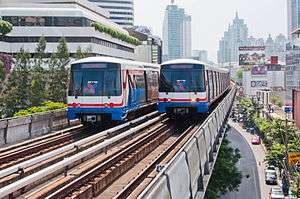
The State Railway of Thailand (SRT) operates all of Thailand's national rail lines. Bangkok Railway Station (Hua Lamphong Station) is the main terminus of all routes. Phahonyothin and ICD Lat Krabang are the main freight terminals. As of 2017 SRT had 4,507 km (2,801 mi) of track, all of it meter gauge except the Airport Link. Nearly all is single-track (4,097 km), although some important sections around Bangkok are double (303 km or 188 mi) or triple-tracked (107 km or 66 mi) and there are plans to extend this.[170] Rail transport in Bangkok includes long-distance services, and some daily commuter trains running from and to the outskirts of the city during the rush hour, but passenger numbers have remained low. There are also three rapid transit rail systems in the capital.
Thailand has 390,000 km (242,335 miles) of highways.[171] According to the BBC Thailand has 462,133 roads and many multi-lane highways. As of 2017 Thailand has 37 million registered vehicles, 20 million of them motorbikes. A number of undivided two-lane highways have been converted into divided four-lane highways. A Bangkok – Chon Buri motorway (Route 7) now links to the new airport and Eastern Seaboard. There are 4,125 public vans operating on 114 routes from Bangkok alone.[172] Other forms of road transport includes tuk-tuks, taxis—as of November 2018, Thailand has 80,647 registered taxis nationwide[173]—vans (minibus), motorbike taxis and songthaews.
.jpg)
As of 2012, Thailand had 103 airports with 63 paved runways, in addition to 6 heliports. The busiest airport in the county is Bangkok's Suvarnabhumi Airport.
Energy
75% of Thailand's electrical generation is powered by natural gas in 2014.[174] Coal-fired power plants produce an additional 20% of electricity, with the remainder coming from biomass, hydro, and biogas.[174]
Thailand produces roughly one-third of the oil it consumes. It is the second largest importer of oil in SE Asia. Thailand is a large producer of natural gas, with reserves of at least 10 trillion cubic feet. After Indonesia, it is the largest coal producer in SE Asia, but must import additional coal to meet domestic demand.
Informal economy
Thailand has a diverse and robust informal labour sector—in 2012, it was estimated that informal workers comprised 62.6% of the Thai workforce. The Ministry of Labour defines informal workers to be individuals who work in informal economies and do not have employee status under a given country's Labour Protection Act (LPA). The informal sector in Thailand has grown significantly over the past 60 years over the course of Thailand's gradual transition from an agriculture-based economy to becoming more industrialised and service-oriented.[175] Between 1993 and 1995, ten percent of the Thai labour force moved from the agricultural sector to urban and industrial jobs, especially in the manufacturing sector. It is estimated that between 1988 and 1995, the number of factory workers in the country doubled from two to four million, as Thailand's GDP tripled.[176] While the Asian Financial Crisis that followed in 1997 hit the Thai economy hard, the industrial sector continued to expand under widespread deregulation, as Thailand was mandated to adopt a range of structural adjustment reforms upon receiving funding from the IMF and World Bank. These reforms implemented an agenda of increased privatisation and trade liberalisation in the country, and decreased federal subsidisation of public goods and utilities, agricultural price supports, and regulations on fair wages and labour conditions.[177] These changes put further pressure on the agricultural sector, and prompted continued migration from the rural countryside to the growing cities. Many migrant farmers found work in Thailand's growing manufacturing industry, and took jobs in sweatshops and factories with few labour regulations and often exploitative conditions.[178]
Those that could not find formal factory work, including illegal migrants and the families of rural Thai migrants that followed their relatives to the urban centres, turned to the informal sector to provide the extra support needed for survival—under the widespread regulation imposed by the structural adjustment programs, one family member working in a factory or sweatshop made very little. Scholars argue that the economic consequences and social costs of Thailand's labour reforms in the wake of the 1997 Asian Financial Crisis fell on individuals and families rather than the state. This can be described as the "externalisation of market risk", meaning that as the country's labour market became increasingly deregulated, the burden and responsibility of providing an adequate livelihood shifted from employers and the state to the workers themselves, whose families had to find jobs in the informal sector to make up for the losses and subsidise the wages being made by their relatives in the formal sector. The weight of these economic changes hit migrants and the urban poor especially hard, and the informal sector expanded rapidly as a result.[177]
Today, informal labour in Thailand is typically broken down into three main groups: subcontracted/self employed/home-based workers, service workers (including those that are employed in restaurants, as street vendors, masseuses, taxi drivers, and as domestic workers), and agricultural workers. Not included in these categories are those that work in entertainment, nightlife, and the sex industry. Individuals employed in these facets of the informal labour sector face additional vulnerabilities, including recruitment into circles of sexual exploitation and human trafficking.[175]
In general, education levels are low in the informal sector. A 2012 study found that 64% of informal workers had not completed education beyond primary school. Many informal workers are also migrants, only some of which have legal status in the country. Education and citizenship are two main barriers to entry for those looking to work in formal industries, and enjoy the labour protections and social security benefits that come along with formal employment. Because the informal labour sector is not recognised under the Labour Protection Act (LPA), informal workers are much more vulnerable labour to exploitation and unsafe working conditions than those employed in more formal and federally recognised industries. While some Thai labour laws provide minimal protections to domestic and agricultural workers, they are often weak and difficult to enforce. Furthermore, Thai social security policies fail to protect against the risks many informal workers face, including workplace accidents and compensation as well as unemployment and retirement insurance. Many informal workers are not legally contracted for their employment, and many do not make a living wage.[175] As a result, labour trafficking is common in the region, affecting children and adults, men and women, and migrants and Thai citizens alike.
Demographics
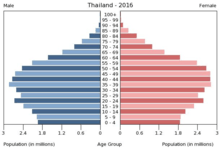
| Population in Thailand[179][180] | |||
|---|---|---|---|
| Year | Million | ||
| 1950 | 20.7 | ||
| 2000 | 62.9 | ||
| 2018 | 69.4 | ||
Thailand had a population of 66,558,935 as of 2019.[4] Thailand's population is largely rural, concentrated in the rice-growing areas of the central, northeastern and northern regions. About 45.7% of Thailand's population lived in urban areas as of 2010, concentrated mostly in and around the Bangkok Metropolitan Area.
Thailand's government-sponsored family planning program resulted in a dramatic decline in population growth from 3.1% in 1960 to around 0.4% today. In 1970, an average of 5.7 people lived in a Thai household. At the time of the 2010 census, the average Thai household size was 3.2 people.
Ethnic groups
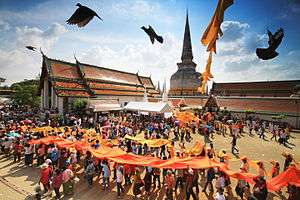
Thai nationals make up the majority of Thailand's population, 95.9% in 2010. The remaining 4.1% of the population are Burmese (2.0%), others 1.3%, and unspecified 0.9%.[1]
According to the Royal Thai Government's 2011 Country Report to the UN Committee responsible for the International Convention for the Elimination of All Forms of Racial Discrimination, available from the Department of Rights and Liberties Promotion of the Thai Ministry of Justice,:3 62 ethnic communities are officially recognised in Thailand. Twenty million Central Thai (together with approximately 650,000 Khorat Thai) make up approximately 20,650,000 (34.1 percent) of the nation's population of 60,544,937[181] at the time of completion of the Mahidol University Ethnolinguistic Maps of Thailand data (1997).[182]
.jpg)
The 2011 Thailand Country Report provides population numbers for mountain peoples ('hill tribes') and ethnic communities in the Northeast and is explicit about its main reliance on the Mahidol University Ethnolinguistic Maps of Thailand data.[182] Thus, though over 3.288 million people in the Northeast alone could not be categorised, the population and percentages of other ethnic communities circa 1997 are known for all of Thailand and constitute minimum populations. In descending order, the largest (equal to or greater than 400,000) are a) 15,080,000 Lao (24.9 percent) consisting of the Thai Lao (14 million) and other smaller Lao groups, namely the Thai Loei (400–500,000), Lao Lom (350,000), Lao Wiang/Klang (200,000), Lao Khrang (90,000), Lao Ngaew (30,000), and Lao Ti (10,000; b) six million Khon Muang (9.9 percent, also called Northern Thais); c) 4.5 million Pak Tai (7.5 percent, also called Southern Thais); d) 1.4 million Khmer Leu (2.3 percent, also called Northern Khmer); e) 900,000 Malay (1.5%); f) 500,000 Nyaw (0.8 percent); g) 470,000 Phu Thai (0.8 percent); h) 400,000 Kuy/Kuay (also known as Suay) (0.7 percent), and i) 350,000 Karen (0.6 percent).:7–13 Thai Chinese, those of significant Chinese heritage, are 14% of the population, while Thais with partial Chinese ancestry comprise up to 40% of the population.[183] Thai Malays represent 3% of the population, with the remainder consisting of Mons, Khmers and various "hill tribes". The country's official language is Thai and the primary religion is Theravada Buddhism, which is practised by around 95% of the population.
Increasing numbers of migrants from neighbouring Myanmar, Laos, and Cambodia, as well as from Nepal and India, have pushed the total number of non-national residents to around 3.5 million as of 2009, up from an estimated 2 million in 2008, and about 1.3 million in 2000.[184] Some 41,000 Britons and 20,000 Australians live in Thailand.[185][186]
Population centres
Language
The official language of Thailand is Thai, a Kra–Dai language closely related to Lao, Shan in Myanmar, and numerous smaller languages spoken in an arc from Hainan and Yunnan south to the Chinese border. It is the principal language of education and government and spoken throughout the country. The standard is based on the dialect of the central Thai people, and it is written in the Thai alphabet, an abugida script that evolved from the Khmer alphabet.
Sixty-two languages were recognised by the Royal Thai Government in the 2011 Country Report to the UN Committee responsible for the International Convention for the Elimination of All Forms of Racial Discrimination, which employed an ethnolinguistic approach and is available from the Department of Rights and Liberties Promotion of the Thai Ministry of Justice.:3 Southern Thai is spoken in the southern provinces, and Northern Thai is spoken in the provinces that were formerly part of the independent kingdom of Lan Na. For the purposes of the national census, which does not recognise all 62 languages recognised by the Royal Thai Government in the 2011 Country Report, four dialects of Thai exist; these partly coincide with regional designations.
The largest of Thailand's minority languages is the Lao dialect of Isan spoken in the northeastern provinces. Although sometimes considered a Thai dialect, it is a Lao dialect, and the region where it is traditionally spoken was historically part of the Lao kingdom of Lan Xang. In the far south, Kelantan-Pattani Malay is the primary language of Malay Muslims. Varieties of Chinese are also spoken by the large Thai Chinese population, with the Teochew dialect best-represented.
Numerous tribal languages are also spoken, including many Austroasiatic languages such as Mon, Khmer, Viet, Mlabri and Orang Asli; Austronesian languages such as Cham and Moken; Sino-Tibetan languages like Lawa, Akha, and Karen; and other Tai languages such as Tai Yo, Phu Thai, and Saek. Hmong is a member of the Hmong–Mien languages, which is now regarded as a language family of its own.
English is a mandatory school subject, but the number of fluent speakers remains low, especially outside cities.
Religion
Thailand's prevalent religion is Theravada Buddhism, which is an integral part of Thai identity and culture. Active participation in Buddhism is among the highest in the world. According to the 2000 census, 94.6% and 93.58% in 2010 of the country's population self-identified as Buddhists of the Theravada tradition. Muslims constitute the second largest religious group in Thailand, comprising 4.29% of the population in 2015.[188]
Islam is concentrated mostly in the country's southernmost provinces: Pattani, Yala, Satun, Narathiwat, and part of Songkhla Chumphon, which are predominantly Malay, most of whom are Sunni Muslims. Christians represented 1.17% (2015) of the population in 2015, with the remaining population consisting of Hindus and Sikhs, who live mostly in the country's cities. There is also a small but historically significant Jewish community in Thailand dating back to the 17th century.
The constitution does not name official state religion, and provides for freedom of religion. Even the authority formally does not register new religious groups that have not been accepted and limit the number of missionaries, unregistered religious organisations as well as missionaries who are allowed to operate freely. There have been no widespread reports of societal abuses or discrimination based on religious belief or practice.[189]
Health
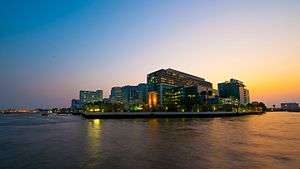
Thailand ranks world's 6th, and Asia's 1st in the 2019 Global Health Security Index of global health security capabilities in 195 countries,[190] making it the only developing country on the world's top ten. Thailand had 62 hospitals accredited by Joint Commission International.[191] In 2002, Bumrungrad became the first hospital in Asia to meet the standard.
Health and medical care is overseen by the Ministry of Public Health (MOPH), along with several other non-ministerial government agencies, with total national expenditures on health amounting to 4.3 percent of GDP in 2009. Non-communicable diseases form the major burden of morbidity and mortality, while infectious diseases including malaria and tuberculosis, as well as traffic accidents, are also important public health issues. The current Minister for Public Health is Anutin Charnvirakul.
In December 2018 the interim parliament voted to legalise the use of cannabis for medical reasons. Recreational use remained unlawful. The National Legislative Assembly had 166 votes in favour of the amendment to the Narcotics Bill, while there were no nay votes and 13 abstentions. The vote makes Thailand the first Southeast Asian country to allow the use of medical cannabis.[192]
Culture

Thai culture and traditions incorporate a great deal of influence from India, China, Cambodia, and the rest of Southeast Asia. Thailand's national religion, Theravada Buddhism, is central to modern Thai identity. Thai Buddhism has evolved over time to include many regional beliefs originating from Hinduism, animism, as well as ancestor worship. The official calendar in Thailand is based on the Eastern version of the Buddhist Era (BE). Thai identity today is a social construct of Phibun regime in 1940s.
Several ethnic groups mediated change between their traditional local culture, national Thai, and global cultural influences. Overseas Chinese also form a significant part of Thai society, particularly in and around Bangkok. Their successful integration into Thai society has allowed them to hold positions of economic and political power. Thai Chinese businesses prosper as part of the larger bamboo network.[193]
Wai is traditional Thai greeting, and is generally offered first by person who is younger or lower in social status and position. Respects for elderly (by age, position, monks, or certain professions) is Thai mores. As with other Asian cultures, respect towards ancestors is an essential part of Thai spiritual practice. Thais have strong sense of social hierarchy, reflecting in many classes of honorifics. Seniority is paramount in Thai culture. Elders have by tradition ruled in family decisions or ceremonies. Older siblings have duties to younger ones.
Thais have a strong sense of hospitality and generosity.
Taboos in Thailand include touching someone's head or pointing with the feet, as the head is considered the most sacred and the foot the lowest part of the body.
Art
The origins of Thai art were very much influenced by Buddhist art and by scenes from the Indian epics. Traditional Thai sculpture almost exclusively depicts images of the Buddha, being very similar with the other styles from Southeast Asia. Traditional Thai paintings usually consist of book illustrations, and painted ornamentation of buildings such as palaces and temples. Thai art was influenced by indigenous civilisations of the Mon and other civilisations. By the Sukothai and Ayutthaya period, thai had developed into its own unique style and was later further influenced by the other Asian styles, mostly by Sri Lankan and Chinese. Thai sculpture and painting, and the royal courts provided patronage, erecting temples and other religious shrines as acts of merit or to commemorate important events.[194]
Traditional Thai paintings showed subjects in two dimensions without perspective. The size of each element in the picture reflected its degree of importance. The primary technique of composition is that of apportioning areas: the main elements are isolated from each other by space transformers. This eliminated the intermediate ground, which would otherwise imply perspective. Perspective was introduced only as a result of Western influence in the mid-19th century. Monk artist Khrua In Khong is well known as the first artist to introduce linear perspective to Thai traditional art.[195]
The most frequent narrative subjects for paintings were or are: the Jataka stories, episodes from the life of the Buddha, the Buddhist heavens and hells, themes derived from the Thai versions of the Ramayana and Mahabharata, not to mention scenes of daily life. Some of the scenes are influenced by Thai folklore instead of following strict Buddhist iconography.[194]
Architecture

Architecture is the preeminent medium of the country's cultural legacy and reflects both the challenges of living in Thailand's sometimes extreme climate as well as, historically, the importance of architecture to the Thai people's sense of community and religious beliefs. Influenced by the architectural traditions of many of Thailand's neighbours, it has also developed significant regional variation within its vernacular and religious buildings.
The Ayutthaya Kingdom movement, which went from approximately 1350 to 1767, was one of the most fruitful and creative periods in Thai architecture The identity of architecture in Ayutthaya period is designed to display might and riches so it has great size and appearance. The temples in Ayutthaya seldom built eaves stretching from the masterhead. The dominant feature of this style is sunlight shining into buildings. During the latter part of the Ayutthaya period, architecture was regarded as a peak achievement that responded to the requirements of people and expressed the gracefulness of Thainess.[196]
Buddhist temples in Thailand are known as "wats", from the Pāḷi vāṭa, meaning an enclosure. A temple has an enclosing wall that divides it from the secular world. Wat architecture has seen many changes in Thailand in the course of history. Although there are many differences in layout and style, they all adhere to the same principles.[197]
Literature
Thai literature has had a long history. Even before the establishment of the Sukhothai Kingdom there existed oral and written works.
During the Sukhothai, Most literary works were written in simple prose with certain alliteration schemes. Major works include King Ram Khamhaeng Inscription. King Ram Khamhaeng's Stone Inscription is considered the first Thai literary work in Thai script. It gives an account of the life of King Ramkhamhaeng the Great, the way of life of Thai people in general, laws, religion, economic and political stability. Trai Phum Phra Ruang, was written in 1345 by King Maha Thammaracha I, the fifth king of Sukhothai. It expounds Buddhist philosophy based on a profound and extensive study with reference to over 30 sacred texts. The work could be considered the nation's first piece of research dissertation. It was written in beautiful prose rich in allusions and imagery. It is a treatise on Buddhist cosmology, ethics, biology and belief system.[198]

During the Ayutthaya, The period produced a variety of forms on diverse subjects. New poetic forms were created, with different rhyme schemes and metres. It is common to find a combination of different poetic forms in one poetic work. Lilit Yuan Phai is a narrative poem describing the war between King Borommatrailokkanat of Ayutthaya and Prince Tilokkarat of Lan Na. One of the most beautiful literary works is Kap He Ruea composed by Prince Thammathibet comparing the scenic beauty to that of his beloved lady on a boat journey in the nirat tradition. Traditionally, the verse is sung during the colourful royal barge procession. It has been the model for subsequent poets to emulate. The same prince also composed the greatly admired Kap Ho Khlong on the Visit to Than Thongdaeng and Kap Ho Khlong Nirat Phrabat.[199]
Despite its short period of 15 years, Thon Buri Period produced Ramakian, a verse drama to which King Taksin the Great contributed his poetic talent. The revival of literature at this time is remarkable since the country had not quite recovered from the aftermath of war. Some poets who later became a major force in the early Rattanakosin Period had already begun writing at this time.
During the 18th century Rattanakosin Period. After sporadic fighting at the beginning of the period, the country gradually returned to normal. It is only natural that many of the early Rattanakosin works should deal with war and military strategy. Some examples are Nirat Rop Phama Thi Tha Din Daeng, Phleng Yao Rop Phama Thi Nakhon Si Thammarat.In the performing arts, perhaps the most important dramatic achievement is the complete work of Ramakian by King Rama I. In addition, There were also verse recitals with musical accompaniment, such as Mahori telling the story of Kaki, Sepha relating the story of Khun Chang Khun Phaen. Other recitals include Sri Thanonchai. The most important Thai poet in this period was Sunthorn Phu (สุนทรภู่) (1786–1855), widely known as "the bard of Rattanakosin" (Thai: กวีเอกแห่งกรุงรัตนโกสินทร์). Sunthorn Phu is best known for his epic poem Phra Aphai Mani (Thai: พระอภัยมณี), which he started in 1822 (while in jail) and finished in 1844. Phra Aphai Mani is a versified fantasy-adventure novel, a genre of Siamese literature known as nithan kham klon (Thai: นิทานคำกลอน).[199]
Music and dance
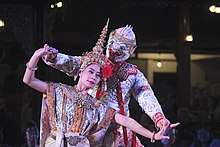
Aside from folk and regional dances (southern Thailand's Menora (dance) and Ramwong, for example), the two major forms of Thai classical dance drama are Khon and Lakhon nai. In the beginning, both were exclusively court entertainments and it was not until much later that a popular style of dance theatre, likay, evolved as a diversion for common folk who had no access to royal performances.[200]
Folk dance forms include dance theater forms like likay, numerous regional dances (ram), the ritual dance ram muay, and homage to the teacher, wai khru. Both ram muay and wai khru take place before all traditional muay Thai matches. The wai is also an annual ceremony performed by Thai classical dance groups to honor their artistic ancestors.
Thai classical music is synonymous with those stylized court ensembles and repertoires that emerged in their present form within the royal centers of Central Thailand some 800 years ago. These ensembles, while being influenced by older practices are today uniquely Thai expressions. While the three primary classical ensembles, the Piphat, Khrueang sai and Mahori differ in significant ways, they all share a basic instrumentation and theoretical approach. Each employs small ching hand cymbals and krap wooden sticks to mark the primary beat reference. Thai classical music has had a wide influence on the musical traditions of neighboring countries. The traditional music of Myanmar was strongly influenced by the Thai music repertoire, called Yodaya (ယိုးဒယား), which was brought over from the Ayutthaya Kingdom. As Siam expanded its political and cultural influence to Laos and Cambodia during the early Rattanakosin period, its music was quickly absorbed by the Cambodia and Lao courts.
Entertainment

Thai films are exported and exhibited in Southeast Asia.[201] Thai cinema has developed its own unique identity and now being internationally recognized for their culture-driven.[202] Films such as Ong-Bak: Muay Thai Warrior (2003) and 'Tom-Yum-Goong (2005), starred Tony Jaa, feature distinctive aspects of Thai martial arts "Muay Thai".
Thai horror has always had a significant cult following, unique take on tales from beyond the grave. More recently, horror films such as Shutter (2004), was one of the best-known Thai horror movies and recognized worldwide.[203] Other examples include The Unseeable (2006), Alone (2007), Body (2007), Coming Soon (2008), 4bia (2008), Phobia 2 (2009), Ladda Land (2011), Pee Mak (2013), and The Promise (2017).
Thai heist thriller film Bad Genius (2017), was one of the most internationally successful Thai film, It broke Thai film earning records in several Asian countries,[204][205] Bad Genius won in 12 categories at the 27th Suphannahong National Film Awards, and also won the Jury Award at the 16th New York Asian Film Festival with a worldwide collection of more than $42 million.[206]
Thailand television dramas, known as Lakorn, Lakorn have become popular in Thailand and its neighbors.[207] Many dramas tend to have a romantic focus, such as Khluen Chiwit, U-Prince, Ugly Duckling, The Crown Princess and teen dramas television series, such as 2gether: The Series, The Gifted, Girl From Nowhere, Hormones: The Series.
The Entertainment industries (film and television) are estimated to have directly contributed $2.1 billion in gross domestic product (GDP) to the Thai economy in 2011. They also directly supported 86,600 jobs.[208] Amongst several Dance-pop artists who have made internationally successful can be mentioned "Lisa" Lalisa Manoban[209] and Tata Young.
Cuisine
Thai cuisine is one of the most popular in the world.[210][211] Thai food blends five fundamental tastes: sweet, spicy, sour, bitter, and salty. The herbs and spices most used in Thai cooking themselves have medicinal qualities such as garlic, lemongrass, Kaffir lime, galangal, turmeric, coriander, coconut milk.[212] Each region of Thailand has its specialities: kaeng khiao wan (green curry) in the central region, som tam (green papaya salad) in the northeast, khao soi in the north, Massaman curry in the south.
In 2017, seven Thai dishes appeared on a list of the "World's 50 Best Foods"— an online poll of worldwide by CNN Travel. Thailand had more dishes on the list than any other country. They were: tom yam goong (4th), pad Thai (5th), som tam (6th), Massaman curry (10th), green curry (19th), Thai fried rice (24th) and mu nam tok (36th).[213]
The staple food in Thailand is rice, particularly jasmine rice (also known as hom Mali) which forms part of almost every meal. Thailand is a leading exporter of rice, and Thais consume over 100 kg of milled rice per person per year.[214]
Units of measurement
Thailand generally uses the metric system, but traditional units of measurement for land area are used, and imperial units of measurement are occasionally used for building materials, such as wood and plumbing fixtures. Years are numbered as B.E. (Buddhist Era) in educational settings, civil service, government, contracts, and newspaper datelines. However, in banking, and increasingly in industry and commerce, standard Western year (Christian or Common Era) counting is the standard practice.[215]
Sports
.jpeg)
Muay Thai (Thai: มวยไทย, RTGS: Muai Thai, [muaj tʰaj], lit. "Thai boxing") is a combat sport of Thailand that uses stand-up striking along with various clinching techniques. Muay Thai became widespread internationally in the late-20th to 21st century, when Westernized practitioners from Thailand began competing in kickboxing and mixed rules matches as well as matches under muay Thai rules around the world, Famous practitioners such as Buakaw Banchamek, Samart Payakaroon, Dieselnoi Chor Thanasukarn and Apidej Sit-Hirun. Buakaw Banchamek has probably brought more international interest in Muay Thai than any other Muay Thai fighters ever had.[216]
Association football has overtaken muay Thai as the most widely followed sport in contemporary Thai society. Thailand national football team has played the AFC Asian Cup six times and reached the semifinals in 1972. The country has hosted the Asian Cup twice, in 1972 and in 2007. The 2007 edition was co-hosted together with Indonesia, Malaysia and Vietnam. It is not uncommon to see Thais cheering their favourite English Premier League teams on television and walking around in replica kit. Another widely enjoyed pastime, and once a competitive sport, is kite flying.
Volleyball is rapidly growing as one of the most popular sports. The women's team has often participated in the World Championship, World Cup, and World Grand Prix Asian Championship. They have won the Asian Championship twice and Asian Cup once. By the success of the women's team, the men team has been growing as well.
Takraw (Thai: ตะกร้อ) is a sport native to Thailand, in which the players hit a rattan ball and are only allowed to use their feet, knees, chest, and head to touch the ball. Sepak takraw is a form of this sport which is similar to volleyball. The players must volley a ball over a net and force it to hit the ground on the opponent's side. It is also a popular sport in other countries in Southeast Asia. A rather similar game but played only with the feet is buka ball.
Snooker has enjoyed increasing popularity in Thailand in recent years, with interest in the game being stimulated by the success of Thai snooker player James Wattana in the 1990s.[217] Other notable players produced by the country include Ratchayothin Yotharuck, Noppon Saengkham and Dechawat Poomjaeng.[218]
Rugby is also a growing sport in Thailand with the Thailand national rugby union team rising to be ranked 61st in the world.[219] Thailand became the first country in the world to host an international 80 welterweight rugby tournament in 2005.[220] The national domestic Thailand Rugby Union (TRU) competition includes several universities and services teams such as Chulalongkorn University, Mahasarakham University, Kasetsart University, Prince of Songkla University, Thammasat University, Rangsit University, the Thai Police, the Thai Army, the Thai Navy and the Royal Thai Air Force. Local sports clubs which also compete in the TRU include the British Club of Bangkok, the Southerners Sports Club (Bangkok) and the Royal Bangkok Sports Club.
Thailand has been called the golf capital of Asia[221] as it is a popular destination for golf. The country attracts a large number of golfers from Japan, Korea, Singapore, South Africa, and Western countries who come to play golf in Thailand every year.[222] The growing popularity of golf, especially among the middle classes and immigrants, is evident as there are more than 200 world-class golf courses nationwide,[223] and some of them are chosen to host PGA and LPGA tournaments, such as Amata Spring Country Club, Alpine Golf and Sports Club, Thai Country Club, and Black Mountain Golf Club.
Basketball is a growing sport in Thailand, especially on the professional sports club level. The Chang Thailand Slammers won the 2011 ASEAN Basketball League Championship.[224] The Thailand national basketball team had its most successful year at the 1966 Asian Games where it won the silver medal.[225]
Other sports in Thailand are slowly growing as the country develops its sporting infrastructure. The success in sports like weightlifting and taekwondo at the last two summer Olympic Games has demonstrated that boxing is no longer the only medal option for Thailand.
Sporting venues
The well-known Lumpinee Boxing Stadium originally sited at Rama IV Road near Lumphini Park hosted its final Muay Thai boxing matches on 8 February 2014 after the venue first opened in December 1956. Managed by the Royal Thai Army, the stadium was officially selected for the purpose of muay Thai bouts following a competition that was staged on 15 March 1956. From 11 February 2014, the stadium will relocate to Ram Intra Road, due to the new venue's capacity to accommodate audiences of up to 3,500. Foreigners typically pay between 1,000–2,000 baht to view a match, with prices depending on the location of the seating.[226]
Thammasat Stadium is a multi-purpose stadium in Bangkok. It is currently used mostly for football matches. The stadium holds 25,000. It is on Thammasat University's Rangsit campus. It was built for the 1998 Asian Games by construction firm Christiani and Nielsen, the same company that constructed the Democracy Monument in Bangkok.
Rajamangala National Stadium is the biggest sporting arena in Thailand. It currently has a capacity of 65,000. It is in Bang Kapi, Bangkok. The stadium was built in 1998 for the 1998 Asian Games and is the home stadium of the Thailand national football team.
Notes
- Thai: ประเทศไทย (/ˈtaɪlænd, ˈtaɪlənd/ TY-land, TY-lənd)
- Thai: สยาม (/saɪˈæm, ˈsaɪæm/)[10][11]
- One of the stated goals of the protest was to remove "Thaksin regime." See "Thai protest leader explains demand for 'people's council'". China.org.cn. 4 December 2013. Retrieved 31 May 2014.
- The latest coup prior to the 2014 coup was the 2007 coup.
- The 2016 Thai constitutional referendum was held on 7 August 2016. Its ratification was held on 6 April 2017.[52]
References
- Thailand Archived 3 July 2015 at the Wayback Machine, The World Factbook.
- John Draper; Joel Sawat Selway (January 2019). "A New Dataset on Horizontal Structural Ethnic Inequalities in Thailand in Order to Address Sustainable Development Goal 10". Social Indicators Research. 141 (4): 284. doi:10.1007/s11205-019-02065-4. Retrieved 6 February 2020.
- "Population by religion, region and area, 2015" (PDF). NSO. Archived from the original (PDF) on 10 December 2017. Retrieved 12 October 2017.
- "Population of the entire kingdom, following the evidence from the population registration on the 31st of December 2019" (PDF). Royal Thai Government Gazette. 30 January 2020. Retrieved 12 June 2020.
- (in Thai) National Statistics Office, "100th anniversary of population censuses in Thailand: Population and housing census 2010: 11th census of Thailand" Archived 12 July 2012 at the Wayback Machine. popcensus.nso.go.th.
- "Thailand". International Monetary Fund. Archived from the original on 3 February 2019. Retrieved 22 April 2019.
- "Thai Economic Performance in Q4 and 2017 and Outlook for 2018". National Economic and Social Development Board. Archived from the original on 22 February 2018. Retrieved 21 February 2018.
- "Gini Index". World Bank. Archived from the original on 4 December 2017. Retrieved 3 December 2017.
- "Human Development Report 2019" (PDF). United Nations Development Programme. 2019. Retrieved 9 December 2019.
- "Siam". Dictionary.com Unabridged. Random House. Retrieved 11 January 2020.
- "Siam definition and meaning". Collins English Dictionary. Retrieved 11 January 2020.
- "American foreign policy. 1950–1955; basic documents". avalon.law.yale.edu.
- "22 U.S. Code § 2321k – Designation of major non-NATO allies". LII / Legal Information Institute.
- Jonathan H. Ping Middle Power Statecraft Archived 5 September 2015 at the Wayback Machine (p 104)
- Thailand and the World Bank Archived 16 December 2005 at the Wayback Machine, World Bank on Thailand country overview.
- The Guardian, Country profile: Thailand, 25 April 2009.
- "Merriam-Webster Online". Merriam-webster.com. 25 April 2007. Archived from the original on 10 April 2010. Retrieved 25 April 2010.
- Eliot, Charles (1921). The Project Gutenberg EBook of Hinduism and Buddhism, An Historical Sketch, Vol. 3 (of 3) [EBook #16847]. London: Routledge & Kegan Paul Ltd. pp. Ch. xxxvii 1, citing in turn Footnote 189: The name is found on Champan inscriptions of 1050 CE and according to Gerini appears in Ptolemy's Samarade = Sâmaraṭṭha. See Gerini, Ptolemy, p. 170. But Samarade is near Bangkok and there can hardly have been Thais there in Ptolemy's time, and Footnote 190: So too in Central Asia Kustana appears to be a learned distortion of the name Khotan, made to give it a meaning in Sanskrit.
- Baker, Christopher; Phongpaichit, Pasuk (2014). A History of Thailand. Singapore: C.O.S Printers Pte Ltd. ISBN 978-1-107-42021-2.
- Thailand (Siam) History, CSMngt-Thai. Archived 24 April 2015 at the Wayback Machine
- Cœdès, George (1968). Walter F. Vella (ed.). The Indianized States of Southeast Asia. Trans. Susan Brown Cowing. University of Hawaii Press. ISBN 978-0-8248-0368-1.CS1 maint: ref=harv (link)
- จิตร ภูมิศักดิ์ 1976: "ความเป็นมาของคำสยาม ไทย ลาวและขอม และลักษณะทางสังคม ของชื่อชนชาติ" (Jid Phumisak 1976: "Coming into Existence for the Siamese Words for Thai, Laotian and Khmer and Societal Characteristics for Nation-names")
- Ferlus, Michel (2009). Formation of Ethnonyms in Southeast Asia Archived 19 November 2016 at the Wayback Machine. 42nd International Conference on Sino-Tibetan Languages and Linguistics, November 2009, Chiang Mai, 2009, p.3.
- Pain, Frédéric (2008). "An Introduction to Thai Ethnonymy: Examples from Shan and Northern Thai". Journal of the American Oriental Society. 128 (4): 641–662. JSTOR 25608449.
- Baker, Chris; Phongpaichit, Pasuk (2017). A History of Ayutthaya. Cambridge University Press. ISBN 978-1-107-19076-4.
- Barbara Leitch LePoer (1989). Thailand: A Country Study. Federal Research Division, Library of Congress.
- Higham, Charles; Higham, Thomas; Ciarla, Roberto; Douka, Katerina; Kijngam, Amphan; Rispoli, Fiorella (10 December 2011). "The Origins of the Bronze Age of Southeast Asia". Journal of World Prehistory. 24 (4): 227–274. doi:10.1007/s10963-011-9054-6. Retrieved 10 February 2018 – via Researchgate.net.
- Thailand. History Archived 2 April 2012 at the Wayback Machine. Encyclopædia Britannica
- Wyatt, David K. (1984). Thailand: A Short History. New Haven: Yale University Press. ISBN 978-0-300-03054-9.
- E. Jane Keyes, James A. Hafner; et al. (2018). "Thailand: History". Encyclopædia Britannica. Retrieved 4 April 2018.
- Charles F. Keyes (1997). Cultural Diversity and National Identity in Thailand. Government policies and ethnic relations in Asia and the Pacific. MIT Press. p. 203.
- Higham, Charles (1989). The Archaeology of Mainland Southeast Asia. Cambridge University Press. ISBN 0-521-27525-3. Retrieved 6 September 2009.CS1 maint: ref=harv (link)
- เกษตรศิริ, ชาญวิทย์ (2005). อยุธยา: ประวัติศาสตร์และการเมือง. โรงพิมพ์มหาวิทยาลัยธรรมศาสตร์. ISBN 978-974-91572-7-5.
- Wyatt, David K. (2013). Thailand: A Short History [ประวัติศาสตร์ไทยฉบับสังเขป] (in Thai). Translated by ละอองศรี, กาญจนี. มูลนิธิโครงการตำราสังคมศาสตร์และมนุษยศาสตร์, มูลนิธิโตโยต้าประเทศไทย. ISBN 978-616-7202-38-9.
- "Ayutthaya history Foreign Settlements".
- Harvey, G E (1925). History of Burma. London: Frank Cass & Co. Ltd.
- Ruangsilp, Bhawan (2007). Dutch East India Company Merchants at the Court of Ayutthaya: Dutch Perceptions of the Thai Kingdom c. 1604–1765. Leiden, Netherlands: Koninklijke Brill NV. ISBN 0-300-08475-7. Retrieved 20 November 2009.CS1 maint: ref=harv (link)
- จรรยา ประชิตโรมรัน. (2548). สมเด็จพระเจ้าตากสินมหาราช. สำนักพิมพ์แห่งจุฬาลงกรณ์มหาวิทยาลัย. หน้า 55
- Nolan, Cathal J. (2002). The Greenwood Encyclopedia of International Relations: S-Z by Cathal J. Nolan. ISBN 978-0-313-32383-6. Retrieved 21 November 2015.
- Hwa, Cheng Siok (1971). "The Crawford Papers — A Collection of Official Records relating to the Mission of Dr. John Crawfurd sent to Siam by the Government of India in the year 1821". Journal of Southeast Asian Studies. 3 (2): 324–325. doi:10.1017/S0022463400019421.
- "Ode to Friendship, Celebrating Singapore – Thailand Relations: Introduction". National Archives of Singapore. 2004. Retrieved 24 April 2007.
- "King, country and the coup". The Indian Express. Mumbai. 22 September 2006. Archived from the original on 14 May 2011. Retrieved 3 November 2011.
- Declaration between Great Britain and France with regard of the Kingdom of Siam and other matters Archived 31 March 2017 at the Wayback Machine London. 15 January 1896. Treaty Series. No. 5
- Werner Gruhl, Imperial Japan's World War Two, 1931–1945, Transaction Publishers, 2007 ISBN 978-0-7658-0352-8
- "The 1973 revolution and its aftermath". Encyclopædia Britannica. Retrieved 23 August 2019.
- "Partial democracy and the search for a new political order". Encyclopædia Britannica. Retrieved 11 March 2018.
- Warr, Peter (2007). Thailand Beyond the Crisis. Routledge Curzon. ISBN 978-1-134-54151-5.
- "Thailand Economic Monitor, November 2005" (PDF). Archived from the original (PDF) on 2 September 2009. Retrieved 19 February 2010.
- Na Ranong, Viroj, Na Ranong, Anchana, Universal Health Care Coverage: Impacts of the 30-Baht Health Care Scheme on the Rural Poor in Thailand, TDRI Quarterly Review, September 2006
- "Protests as Thailand senators debate amnesty bill". The Guardian. 11 November 2013. Retrieved 10 April 2019.
- Beech, Hannah (8 February 2019). "Thailand's King Rejects His Sister's Candidacy for Prime Minister". The New York Times. ISSN 0362-4331. Retrieved 11 February 2019.
- Thai King Signs Military-Backed Constitution, National Public Radio, 6 April 2017
- "Thailand election results delayed as allegations of cheating grow". ABC News. 25 March 2019. Retrieved 26 March 2019.
- "A list of previous coups in Thailand". Associated Press. 19 September 2006. Archived from the original on 16 October 2007. Retrieved 25 April 2010.
- "Raw Data: List of Recent Coups in Thailand's History". Fox News Channel. 19 September 2006. Archived from the original on 6 July 2008. Retrieved 25 April 2010.
- สถิติที่ไม่น่าภูมิใจเมื่อไทยติดอันดับที่ 4 ประเทศที่มีการรัฐประหารบ่อยที่สุดในโลก. Siam Intelligence (in Thai).
- Gray, Denis D. (22 August 2015). "Deadly bombing in military-ruled Thailand adds to mounting woes in one-time 'Land of Smiles'". U.S. News & World Report. Associated Press. Retrieved 23 August 2015.
- "Thailand's juristocracy". 17 May 2014. Archived from the original on 5 September 2015.
- Teehankee, Julio; Tiulegenov, Medet; Wang, Yi-ting; Ciobanu, Vlad; Lindberg, Staffan I. "Party System in South and Southeast Asia: A Thematic Report Based on Data 1900–2012". V-Dem Thematic Report Series, No. 2, October 2013.
- Croissant, Aurel; Völkel, Philip (21 December 2010). "Party system types and party system institutionalization: Comparing new democracies in East and Southeast Asia". Party Politics. 18 (2). doi:10.1177/1354068810380096.
- "Thailand's constitution: New era, new uncertainties". BBC News. 7 April 2017.
- Champion, Paul (25 September 2007). "Professor in lese majeste row". Reuters. Archived from the original on 13 October 2007.
- 2014 coup marks the highest number of lèse-majesté prisoners in Thai history. Prachatai.
- "Thailand jails man for 35 years for insulting the monarchy on Facebook". The Independent. 10 June 2017.
- "Thailand". freedomhouse.org. 5 January 2018.
- "Somyot lese majeste judgement on Wednesday". The Bangkok Post. 22 January 2013.
- "Thailand: Release human rights defender imprisoned for insulting the monarchy". Amnesty International. 23 January 2013. Archived from the original on 29 January 2013. Retrieved 21 December 2018.
- "The Climate of Thailand" (PDF). Thai Meteorological Department. Archived (PDF) from the original on 1 August 2016. Retrieved 18 August 2016.
- Dr. Susan L. Woodward (1997–2014). "Tropical Savannas". Biomes of the World. S. L. Woodward. Archived from the original on 19 December 2013. Retrieved 23 February 2014.
- Overland, Indra et al. (2017) Impact of Climate Change on ASEAN International Affairs: Risk and Opportunity Multiplier, Norwegian Institute of International Affairs (NUPI) and Myanmar Institute of International and Strategic Studies (MISIS).
- "Report: Flooded Future: Global vulnerability to sea level rise worse than previously understood". climatecentral.org. 29 October 2019.
- "Thailand's Elephants". Thai Elephant Conservation Center. Archived from the original on 5 March 2015. Retrieved 3 March 2015.
- "2016 Report". EPI Report. Archived from the original on 4 February 2016. Retrieved 17 December 2016.
- EPI (2016): Thailand Archived 27 December 2016 at the Wayback Machine
- "Poaching for meat poses new extinction risk to Thai elephants". The Guardian. Associated Press. 26 January 2012. Archived from the original on 5 February 2018. Retrieved 4 February 2018.
- Hile, Jennifer (6 October 2002). "Activists Denounce Thailand's Elephant "Crushing" Ritual". National Geographic Today. Archived from the original on 18 February 2007. Retrieved 7 June 2007.
- Teena Amrit Gill (18 February 1997). "Endangered Animals on Restaurant Menus". Albion Monitor/News. Archived from the original on 16 May 2007. Retrieved 7 June 2007.
- "Thai Forests: Dept. National Parks, Wildlife & Plants". Thai Society for the Conservation of Wild Animals. Archived from the original on 26 November 2014.
- "Number of Administrative Units 2019" (scroll down). Changwat, Amphoe, Tambon. 4 March 2020. Retrieved 16 June 2020.
- "LOCAL PERSONNEL ADMINISTRATION B.E. 2542 (1999)" (PDF). Department of Local Administration (DLA). Retrieved 11 December 2017.
- "FTA Watch Group website". Ftawatch.org. Archived from the original on 22 August 2009. Retrieved 25 April 2010.
- John D. Ciorciari (10 March 2004). "Thaksin's Chance for Leading Role in the Region". The Straits Times. Singapore. Archived from the original on 26 April 2013.
- 'Thaksin to face charges over Burma telecom deal. ICT News, 2 August 2007
- "Thailand sends troops to bolster US occupation of Iraq". World Socialist Web Site. Archived from the original on 19 June 2015. Retrieved 28 January 2015.
- The Telegraph, Troops from Thailand and Cambodia fight on border Archived 23 May 2010 at the Wayback Machine, 3 April 2009
- Bloomberg, Thai, Cambodian Border Fighting Stops, Thailand Says Archived 14 October 2007 at the Wayback Machine, 3 April 2009
- "Thailand Military Strength". Global Firepower. Archived from the original on 8 February 2015. Retrieved 15 December 2014.
- Chapter 2 of the 2007 Constitution of Thailand
- Pike, John (27 April 2005). "Ministry of Defense". GlobalSecurity.org. Archived from the original on 9 April 2010. Retrieved 25 April 2010.
- "Bullets, cluster bombs at Thai arms fair despite censure over junta rule". Agence France Presse. 4 November 2015. Retrieved 8 November 2015.
- "Thailand Raises Defence Budget 5%". Defense Studies. 17 July 2014. Retrieved 8 November 2015.
- "Thailand Offers Persecuted Rohingya Little Hope". hrw.org.
- "Battlefield Bangkok: The Royal Thai Army 2000–2014". Dean Wilson.
- Chapter 4 of the 2007 Constitution of Thailand
- "Let's stop forcing boys to be soldiers" (Opinion). The Nation. 29 August 2018. Archived from the original on 28 August 2018. Retrieved 29 August 2018.
- "Do away with conscription" (Opinion). Bangkok Post. 24 March 2018. Retrieved 29 August 2018.
- "Prawit denies servant for officer policy". Bangkok Post. 18 July 2018. Retrieved 18 July 2018.
- "Ex-private stands firm after being harassed online for criticising military". Pratchatai English. 3 November 2017. Archived from the original on 7 November 2017. Retrieved 4 November 2017.
- "Conscripts aren't servants" (Opinion). Bangkok Post. 19 July 2018. Retrieved 20 July 2018.
- "Weeks after Korat massacre, Amnesty report describes conscript abuses". Bangkok Post. Reuters. 23 March 2020. Retrieved 23 March 2020.
- "Thailand's Deep State—The Military". Asia Sentinel. 14 November 2017. Retrieved 15 November 2017.
- Thai Navy Accused of Involvement In Smuggling Rohingya Muslims
- ""บิ๊กติ๊ก"ตั้งลูก ติดยศทหาร อ้างให้งานทำ". โพสต์ทูเดย์. 16 April 2016. Retrieved 29 August 2018.
- "Thai Junta Fills Senate with Military, Police Officers". benarnews.
- "Thailand signs, ratifies anti-nukes treaty at UN". Bangkok Post. 22 September 2017.
- "Thailand-Youth literacy rate". knoema.
- "Education in Thailand". WENR.
- "สถิติอุดมศึกษา Higher Education Statistics 2558–2560" (PDF). Ofice of The higher Education Commission.
- "University Ranking". topuniversities.
- ""9 มหาวิทยาลัยวิจัยแห่งชาติ" มีสถาบันไหนในไทยบ้างที่ถูกยกให้เป็นสถาบันที่เด่นด้านวิจัย". Sanook.
- "Rethinking Thai higher education for Thailand 4.0". emerald.
- "The world's largest ranking of countries and regions by English skills". EF English Proficiency Index.
- Draper, John (2012), "Revisiting English in Thailand", Asian EFL Journal, 14 (4): 9–38, ISSN 1738-1460, archived from the original on 12 March 2014
- OECD (2013), Structural Policy Country Notes: Thailand (PDF), OECD, archived (PDF) from the original on 12 March 2014
- Khaopa, Wannapa (12 December 2012). "Thai students drop in world maths and science study". The Nation. Archived from the original on 12 March 2014.
- Draper, John (12 December 2011). "Solving Isaan's education problem". The Isaan Record. Archived from the original on 26 February 2013.
- Draper, John (21 February 2014). "PISA Thailand regional breakdown shows inequalities between Bangkok and Upper North with the rest of Thailand". The Isaan Record. Archived from the original on 12 March 2014.
- "MOPH reports low IQ among Thai youth : National News Bureau of Thailand". Thainews.prd.go.th. 8 July 2011. Archived from the original on 8 July 2011. Retrieved 3 November 2011.
- "Thailand Provides 27,231 Schools With Internet". 11 March 2013. Archived from the original on 16 July 2014. Retrieved 30 January 2015.
- "Thailand's gypsy pharmacist: a champion of affordable drugs". SciDevNet. 30 October 2019. Retrieved 31 October 2019.
- "Heroes in the Field: Krisana Kraisintu". Bill Gates(gatesnotes).
- "เภสัชกรยิปซี : กฤษณา ไกรสินธุ์ กับโครงการสุดท้ายในชีวิต". BBC Thai.
- "'พงศ์ราม รามสูต' ผู้คิดยารักษา'ไข้เลือดออก'คนแรกของโลก". Bangkokbiznews.
- "Thailand Board of Investment to help promote medical robotics". mobihealthnews.
- "A Thai-made robot that takes care of those with Alzheimer's". inquirer.
- "Thailand's first robot to help in epilepsy surgery cases unveiled". thaipbsworld.
- "Ramathibodi Hospital pioneers robot-assisted neurosurgery". nationthailand.
- "Robots for life: Thailand's medical robotics get promoted" (PDF). INVESTMENT SERVICES CENTER THE BOARD OF INVESTMENT OFFICE OF THE PRIME MINISTER.
- "Research and development expenditure (% of GDP)". worldbank.
- "Thailand Taking off to New Heights" (PDF). SCG.
- "EEC english edition 1" (PDF). eeco.
- "NSTDA Profile". NSTDA. Retrieved 20 March 2016.
- "Archived copy" รายได้ประชาชาติของประเทศไทย พ.ศ. ๒๕๕๙ แบบปริมาณลูกโซ่ (in Thai). Office of the National Economic and Social Development Board. Archived from the original on 26 April 2018. Retrieved 23 April 2018.CS1 maint: archived copy as title (link)
- "Archived copy" ภาวะเศรษฐกิจไทยไตรมาสที่สี่ ทั้งปี 2560 และแนวโน้มปี 2561 (in Thai). Office of the National Economic and Social Development Board. 2018. Archived from the original on 27 April 2018. Retrieved 23 April 2018.CS1 maint: archived copy as title (link)
- ภาวะสังคมไทยไตรมาสสี่และภาพรวม ปี 2560 (PDF) (in Thai). Office of the National Economic and Social Development Board. Archived from the original (PDF) on 26 April 2018. Retrieved 23 April 2018.
- ข้อมูลหนี้สาธารณะคงค้าง (in Thai). Public Debt Management Office. Archived from the original on 26 April 2018. Retrieved 18 February 2018.
- เสรีวรวิทย์กุล, ชนาภรณ์; รุ่งเจริญกิจกุล, ภูริชัย (July 2011). ฐานะทางการเงินของภาคครัวเรือนและผลของความมั่งคั่งต่อการบริโภค (PDF) (in Thai). Bank of Thailand. Retrieved 24 April 2018.
- "GDP (PURCHASING POWER PARITY)". CIA.gov. Central Intelligence Agency. Retrieved 25 January 2019.
- "NESDB: Thailand facing unemployment problem". Pattaya Mail. 25 November 2014. Archived from the original on 4 January 2015. Retrieved 4 January 2015.
- Jones, Aidan (31 January 2014). "Thai northeast vows poll payback to Shinawatra clan". Agence France-Presse. Retrieved 8 February 2014.
- Phromchanya, Phisanu (24 February 2012). "Thailand Economy To Rebound Strongly In 2012". The Wall Street Journal. Archived from the original on 15 October 2015. Retrieved 26 April 2012.
- "CThailand's GDP grows at fastest pace in 5 years in 2017". Nikkei Asian.
- Global Wealth Report 2016. Zurich: Credit Suisse AG. November 2016. Archived from the original on 15 May 2017. Retrieved 1 July 2017.
- "Table 3: Inequality-adjusted Human Development Index". Human Development Report Office, United Nations Development Programme. Retrieved 25 April 2018.
- "Archived copy" บทสรุปผู้บริหาร การสำรวจภาวะเศรษฐกิจและสังคมของครัวเรือน พ.ศ. 2560 (PDF) (in Thai). National Statistical Office. Archived from the original (PDF) on 26 April 2018. Retrieved 25 April 2018.CS1 maint: archived copy as title (link)
- รายงานการวิเคราะห์สถานการณ์ความยากจนและความเหลื่อมล้าในประเทศไทย ปี 2559 (PDF) (in Thai). Office of the National Economic and Social Development Board. 2016. Archived from the original (PDF) on 26 April 2018. Retrieved 24 April 2018.
- "Profile of the Protestors: A Survey of Pro and Anti-Government Demonstrators in Bangkok on November 30, 2013" (PDF). Asia Foundation. December 2013. Retrieved 24 April 2018.
- พงศ์พิพัฒน์ บัญชานนท์ (18 June 2017). ยิ่งนานยิ่งถ่าง ช่องว่างทางรายได้ ปัญหาใหญ่ที่รอ คสช. แก้. BBC Thailand (in Thai). Retrieved 25 April 2018.
- สสส. เผยสถานการณ์คนไร้บ้าน ทั่วประเทศกว่า 3 หมื่นคน. posttoday.com (in Thai). 16 June 2017. Retrieved 25 April 2018.
- Santivimolnat, Santan (18 August 2012). "2-million milestone edges nearer". Bangkok Post.
- Languepin, Olivier (3 January 2013). "Thailand poised to Surpass Car Production target". Thailand Business News. Archived from the original on 15 January 2013. Retrieved 20 January 2013.
- "Production Statistics". OICA (International Organization of Motor Vehicle Manufacturers). Archived from the original on 6 November 2013. Retrieved 26 November 2012.
- Takahashi, Toru (27 November 2014). "Thailand's love affair with the pickup truck". Nikkei Asian Review. Archived from the original on 3 January 2015. Retrieved 4 January 2015.
- Finlay, Steve (6 July 2012). "Pickup Trucks Reign in Thailand". Ward's.
- "Government moves to head off tourist fears". Bangkok Post. 24 August 2015. Retrieved 24 August 2015.
- Travel and Tourism, Economic Impact 2014: Thailand (PDF) (2014 ed.). London: World Travel & Tourism Council. 2014. Archived from the original (PDF) on 19 March 2015. Retrieved 10 March 2015.
- Tourist Police in Thailand Archived 3 July 2008 at the Wayback Machine. Amazing-Thailand.com. Retrieved on 16 September 2010.
- "Medical Tourism in Thailand". MyMediTravel. Retrieved 17 February 2019.
- "Medical Tourism Report". WTTC. Archived from the original on 16 May 2020. Retrieved 15 May 2020.
- Chokrungvaranont, Prayuth, Gennaro Selvaggi, Sirachai Jindarak, Apichai Angspatt, Pornthep Pungrasmi, Poonpismai Suwajo, and Preecha Tiewtranon. "The Development of Sex Reassignment Surgery in Thailand: A Social Perspective". The Scientific World Journal. Hindawi Publishing Corporation, 2014. Web. 23 March 2017.
- Ocha, Witchayanee. "Transsexual emergence: gender variant identities in Thailand". Culture, Health & Sexuality14.5 (2012): 563–575. Web.
- Thailand mulls legal prostitution. Archived 8 July 2011 at Wikiwix The Age, 26 November 2003
- Martin, Lorna. "Paradise Revealed". Taipei Times. Archived from the original on 2 December 2014. Retrieved 29 January 2015.
- Henri Leturque and Steve Wiggins 2010. Thailand's progress in agriculture: Transition and sustained productivity growth Archived 27 April 2011 at the Wayback Machine. London: Overseas Development Institute
- International Grains Council. "Grain Market Report (GMR444)" Archived 2 July 2014 at the Wayback Machine, London, 14 May 2014. Retrieved 13 June 2014.
- "CIA World Factbook – Greater Mekong Subregion". Cia.gov. Archived from the original on 26 March 2014. Retrieved 3 November 2011.
- "Rice Around The World. Thailand". Irri.org. Archived from the original on 27 March 2008. Retrieved 25 April 2010.
- "Country Trends". Global Footprint Network. Retrieved 9 October 2019.
- Lin, David; Hanscom, Laurel; Murthy, Adeline; Galli, Alessandro; Evans, Mikel; Neill, Evan; Mancini, Maria Serena; Martindill, Jon; Medouar, Fatime-Zahra; Huang, Shiyu; Wackernagel, Mathis (2018). "Ecological Footprint Accounting for Countries: Updates and Results of the National Footprint Accounts, 2012–2018". Resources. 7 (3): 58. doi:10.3390/resources7030058.
- Thongkamkoon, Chaiwat. "Thailand's Railway Development Strategy 2015–2022" (PDF). Railway Technology Development Institute of Thailand. Retrieved 28 November 2014.
- Janssen, Peter (23 January 2017). "Thailand's expanding state 'threatens future growth'". Nikkei Asian Review. Retrieved 23 January 2017.
- Mahittirook, Amornrat (7 November 2016). "Public vans likely to offer 10% fare cut". Bangkok Post. Retrieved 7 November 2016.
- "The meter is ticking" (Opinion). Bangkok Post. 14 November 2018. Retrieved 14 November 2018.
- "International Index of Energy Security Risk" (PDF). Institute for 21st Century Energy. Institute for 21st Century Energy. 2013. Archived (PDF) from the original on 4 January 2015. Retrieved 14 September 2014.
- Kongtip, Pornpimol et al. "Informal Workers in Thailand: Occupational Health and Social Security Disparities". New solutions : a journal of environmental and occupational health policy : NS 25.2 (2015): 189–211. PMC. Web. 12 March 2018.
- Bales, Kevin. Disposable People : New Slavery in the Global Economy. ProQuest Ebook Central. University of California Press.
- Guille, Howard (2014). "Reforming Asian Labor Systems: Economic Tensions and Worker Dissent". Asian Studies Review. 39.
- Warunsiri, Sasiwimon (2011). "The Role of Informal Sector in Thailand" (PDF). Research Institute for Policy Evaluation and Design.
- ""World Population prospects – Population division"". population.un.org. United Nations Department of Economic and Social Affairs, Population Division. Retrieved 9 November 2019.
- ""Overall total population" – World Population Prospects: The 2019 Revision" (xslx). population.un.org (custom data acquired via website). United Nations Department of Economic and Social Affairs, Population Division. Retrieved 9 November 2019.
- "Population total – Thailand". World Bank Group. Archived from the original on 13 October 2016. Retrieved 12 October 2016.
- Ethnolinguistic Maps of Thailand (PDF) (in Thai). Office of the National Culture Commission. 2004. Archived (PDF) from the original on 9 October 2016. Retrieved 8 October 2016.
- Luangthongkum, Theraphan (2007). "The Position of Non-Thai Languages in Thailand". Language, Nation and Development in Southeast Asia: 191.
- Thailand: Burmese migrant children missing out on education. IRIN Asia. 15 June 2009. Archived 27 February 2012 at the Wayback Machine
- McGeown, Kate (14 December 2006). "Hard lessons in expat paradise". BBC News. Archived from the original on 9 June 2011. Retrieved 1 March 2015.
- "Speech to the Australian-Thai Chamber of Commerce". Australian Minister for Foreign Affairs and Trade. 3 July 2008. Archived from the original on 12 June 2019. Retrieved 12 November 2019.
- "Population by religion, region and area, 2015" (PDF). NSO. Archived from the original (PDF) on 10 December 2017. Retrieved 12 October 2017.
- "US Department of State, Thailand". State.gov. Retrieved 25 April 2010.
- United States Bureau of Democracy, Human Rights and Labor. Thailand: International Religious Freedom Report 2007. The article incorporates text from this source, which is in the public domain.
- "2019 Global Health Security Index". GHS INDEX.
- "Search for JCI-Accredited Organizations". JCI.
- Olam, Kocha; Goldschmidt, Debra (25 December 2018). "Thailand approves medical marijuana". CNN. Retrieved 26 December 2018.
- Murray L Weidenbaum (1996). The Bamboo Network: How Expatriate Chinese Entrepreneurs are Creating a New Economic Superpower in Asia. Martin Kessler Books, Free Press. pp. 4–8. ISBN 978-0-684-82289-1.
- "Buddhist Arts of Thailand" (PDF).
- PCL, Post Publishing. "Wat Borommaniwat". www.bangkokpost.com.
- "โครงการจักทำองค์ความรู้ด้านการสำรวจสถาปัตยกรรมเพื่อการอนุรักษ์โบราณสถาน" (PDF). Fine Arts Department, Ministry of Culture(Thailand). Archived from the original (PDF) on 13 December 2019. Retrieved 13 December 2019.
- "วัด" (PDF).
- "Thai literature". ENCYCLOPÆDIA BRITANNICA.
- "Culture Overview : Literature and Performances". thaiembassy.
- "Thai Traditional Dances – Dance costume Thailand". Thai to Siam. Archived from the original on 3 February 2020. Retrieved 12 May 2020.
- "Expanding the Asean screen". Bangkokpost.
- "Thai films get in on the action". Hollywoodreporter.
- ""Shutter" a bland horror remake". Reuters.
- "'Thai wave' in showbiz poised for big splash in China". NIKKEI Asian Review.
- "Thailand movie 'Bad Genius' wins big in China". Globaltimes.
- "From Singapore to Malaysia: Markets Leading the Expansion of Southeast Asian Cinema". Hollywoodreporter.
- "Thailand's 'lakorn' soap operas come to PH". Inquirer.net.
- "The economic contribution of the film and television industries in Thailand" (PDF). Oxford Economics.
- "7 Rising Style Stars to Watch in 2020". VOGUE.
- "Which country has the best food?". CNN Travel.
- "The Best Countries In The World For Food Lovers, Ranked". roughmaps.
- "Thai Food for Health (part 2)". thai-food-online. Archived from the original on 3 June 2020. Retrieved 19 May 2020.
- Tim Cheung (12 July 2017). "Your pick: World's 50 best foods". CNN. Archived from the original on 8 July 2017. Retrieved 5 May 2018.
- "World Rice Statistics Online Query Facility". International Rice Research Institute (IRRI). FAO. 2013. Archived from the original on 26 April 2016. Retrieved 30 January 2016.
- "Weights and measures in Thailand". Cockatoo.com. 17 December 1923. Archived from the original on 10 October 2017. Retrieved 25 April 2010.
- "Top 10 Muay Thai Fighters You Should Know". muaythaicitizen.
- Hodgson, Guy (18 April 1993). "Snooker: A storm coming in from the East: Thailand doesn't boast many world-beating sportsmen. But over the next fortnight James Wattana might just become one". The Independent. London. Archived from the original on 2 April 2015. Retrieved 25 January 2015.
- Goyder, James (11 January 2014). "South East Asians proving high earners on the tables". thenational.ae. Archived from the original on 15 March 2015. Retrieved 25 January 2015.
- "International Rugby Board – THAILAND". International Rugby Board. Archived from the original on 28 September 2011. Retrieved 25 April 2010.
- The Nation Archived 25 April 2011 at the Wayback Machine, 19 July 2005
- "Golf in Thailand by". Golfasia.com. Archived from the original on 1 May 2010. Retrieved 25 April 2010.
- Nualkhair, Chawadee (10 July 2009). "Thailand woos foreign golfers with sun, sand traps". Reuters. Archived from the original on 15 July 2009. Retrieved 25 April 2010.
- "Why to book with golf2thailand.com : Thailand Golf Courses Thailand Golf Packages". Golf2thailand.com. Archived from the original on 15 June 2006. Retrieved 25 April 2010.
- "Chang Thailand Slammers – AirAsia ASEAN Basketball League". aseanbasketballleague.com. Archived from the original on 5 June 2012. Retrieved 2 June 2012.
- "Thailand Basketball". best-basketball-tips.com. 18 May 2012. Archived from the original on 1 May 2012. Retrieved 2 June 2012.
- "End of an era for Muay Thai at Lumpini". Bangkok Post. 6 February 2014. Retrieved 6 February 2014.
Further reading
- Yuko, Elizabeth (29 August 2019). "Pictures of the Thai King's Consort Broke the Internet – But What's a Consort?". Rolling Stone.
- Beech, Hannah (7 November 2019). "'Extremely Evil Misconduct': Thailand's Palace Intrigue Spills into View". The New York Times. Archived from the original on 10 November 2019. Retrieved 10 November 2019.
External links
- Government
- Thaigov.go.th – Government of Thailand
- Chief of State and Cabinet Members
- Mfa.go.th – Ministry of Foreign Affairs
- Thailand Internet information – National Electronics and Computer Technology Center
- Ministry of Culture
- General information
- "Thailand". The World Factbook. Central Intelligence Agency.
- Thailand entry in Library of Congress Country Studies. 1987
- Thailand from UCB Libraries GovPubs
- Thailand at Curlie
- Thailand from the BBC News
- Thailand Encyclopædia Britannica entry

- Longdo Map – Thailand maps in English and Thai
- Key Development Forecasts for Thailand from International Futures
- 2010 Thailand population census by Economic and Social statistics Bureau
- Travel
- Tourism Authority of Thailand – official tourism website
- Other
- Thailand Country Fact Sheet from the Common Language Project
- Southeast Asia Visions. "Browse the Southeast Asia Visions Collection". Cornell University Library.

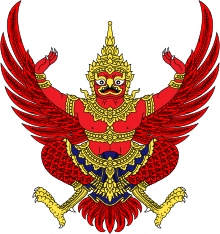
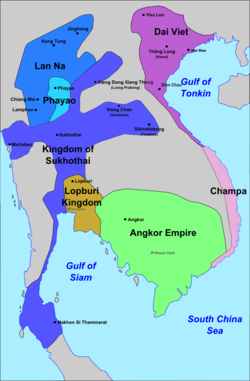
.jpg)
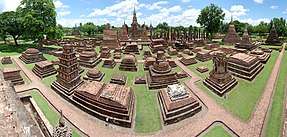
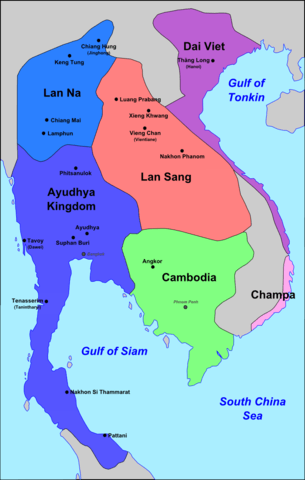


.jpg)
.svg.png)

.png)
_2016.jpg)

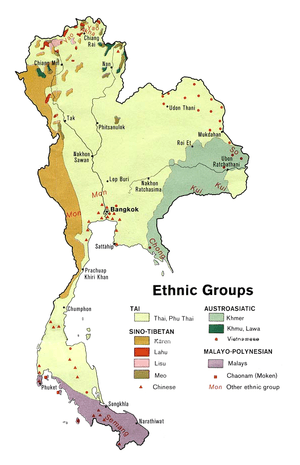
.jpg)
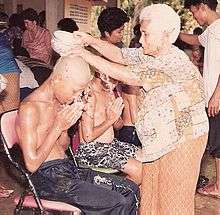

.svg.png)
